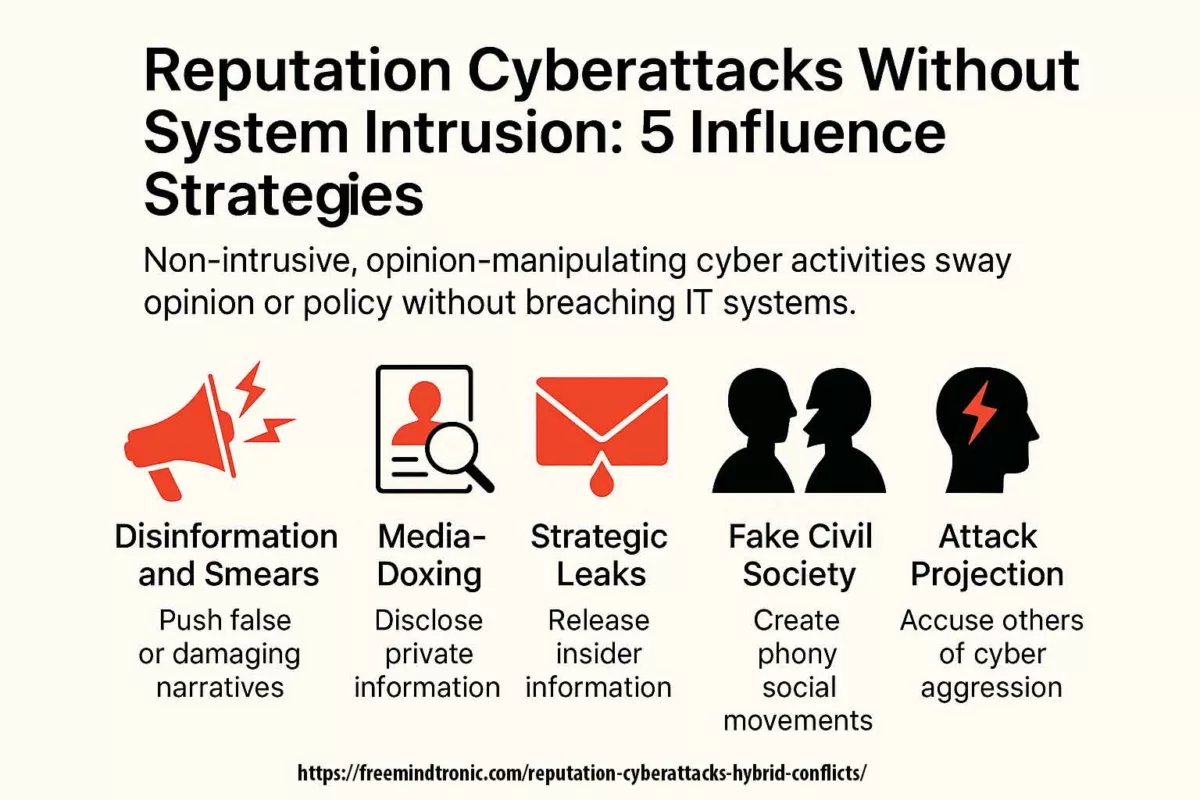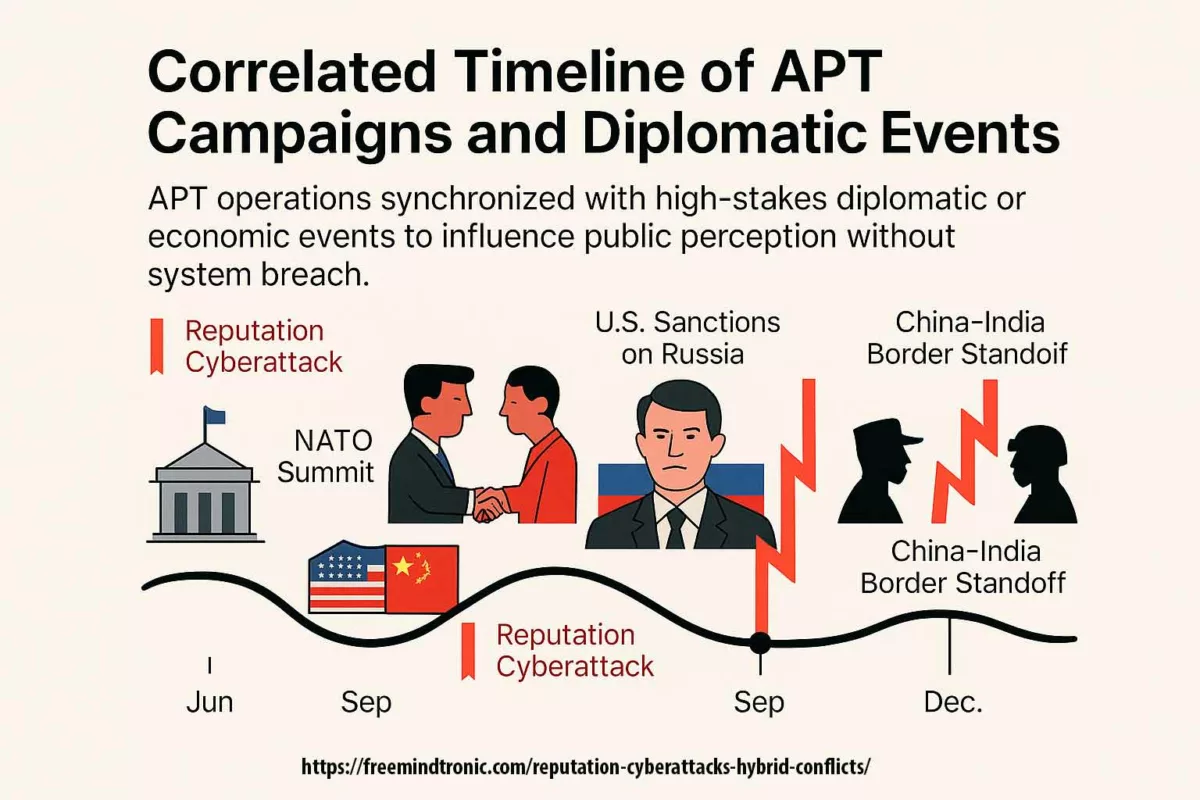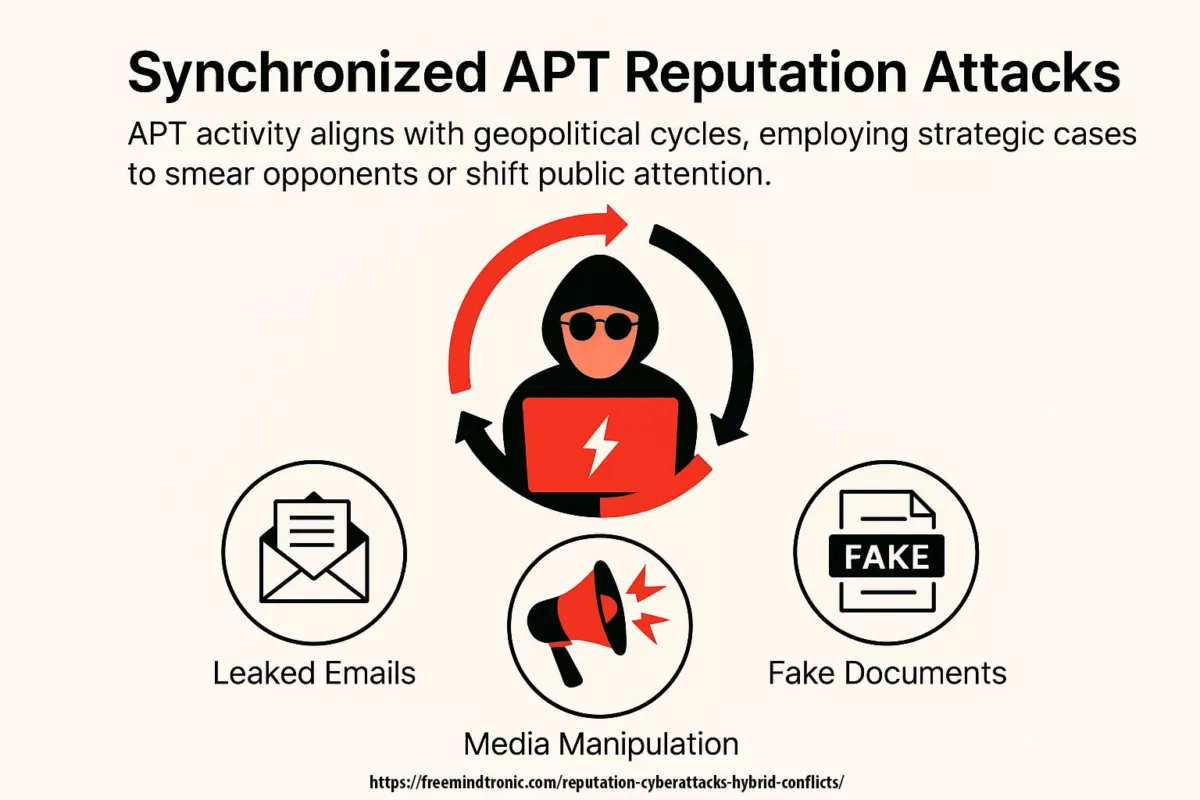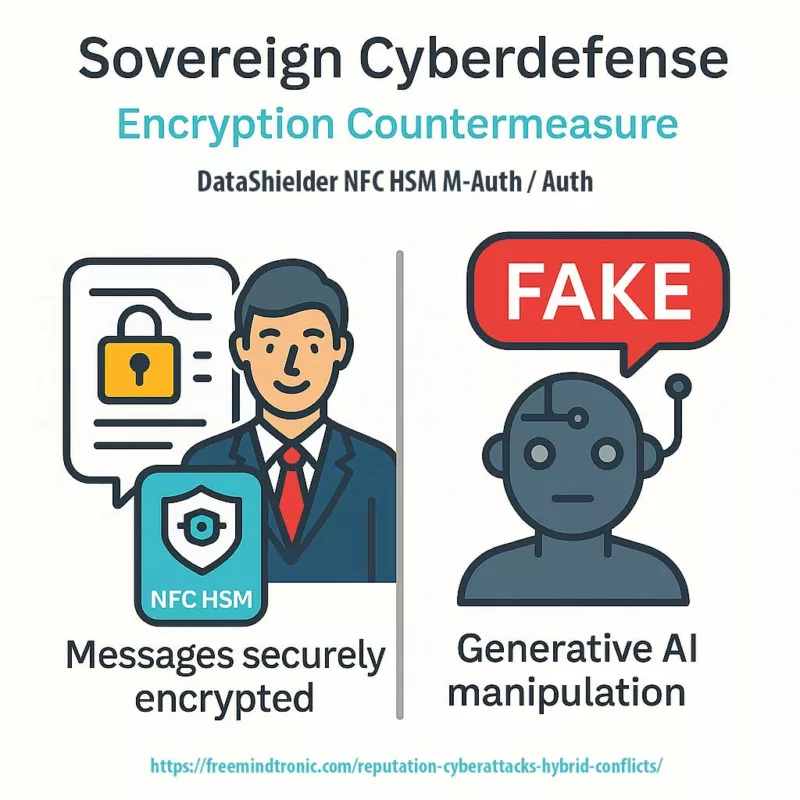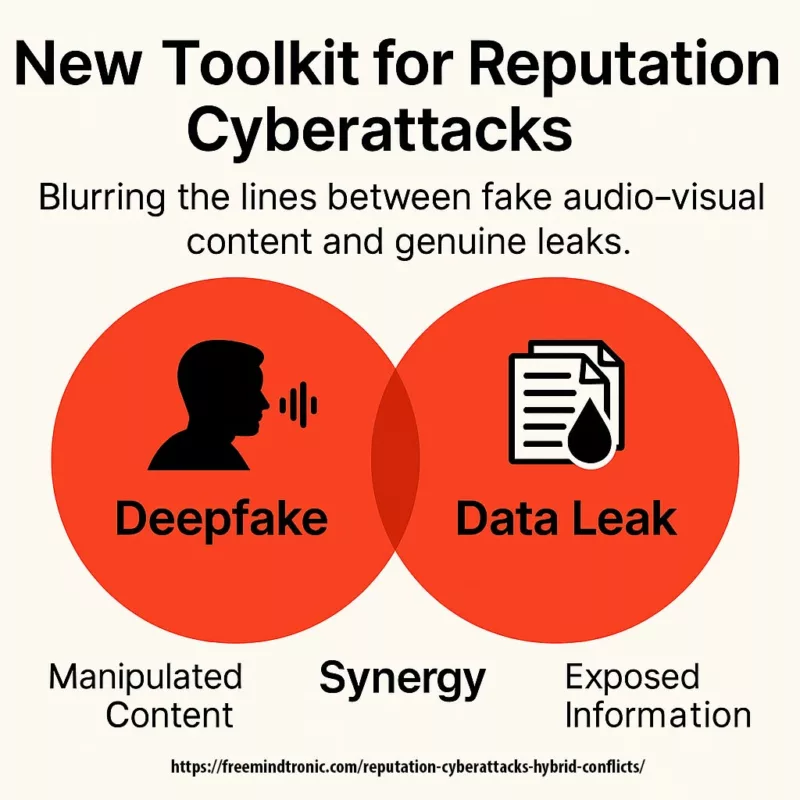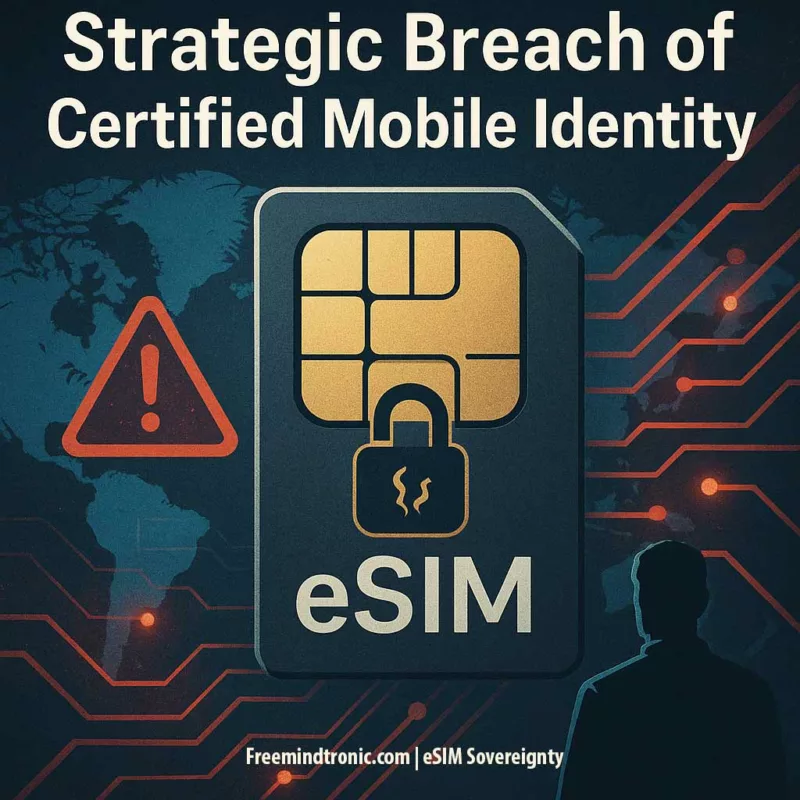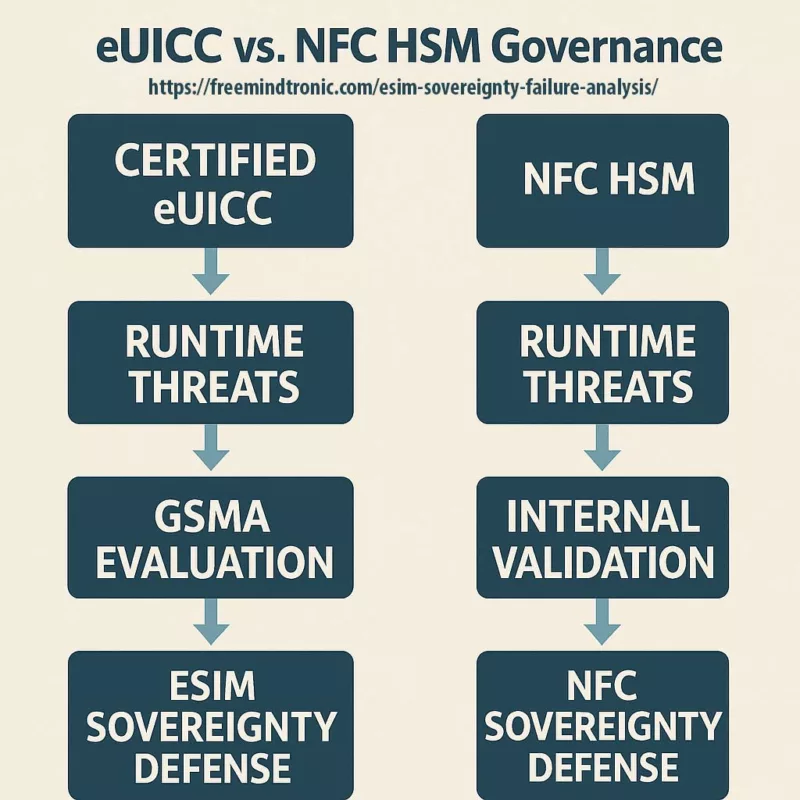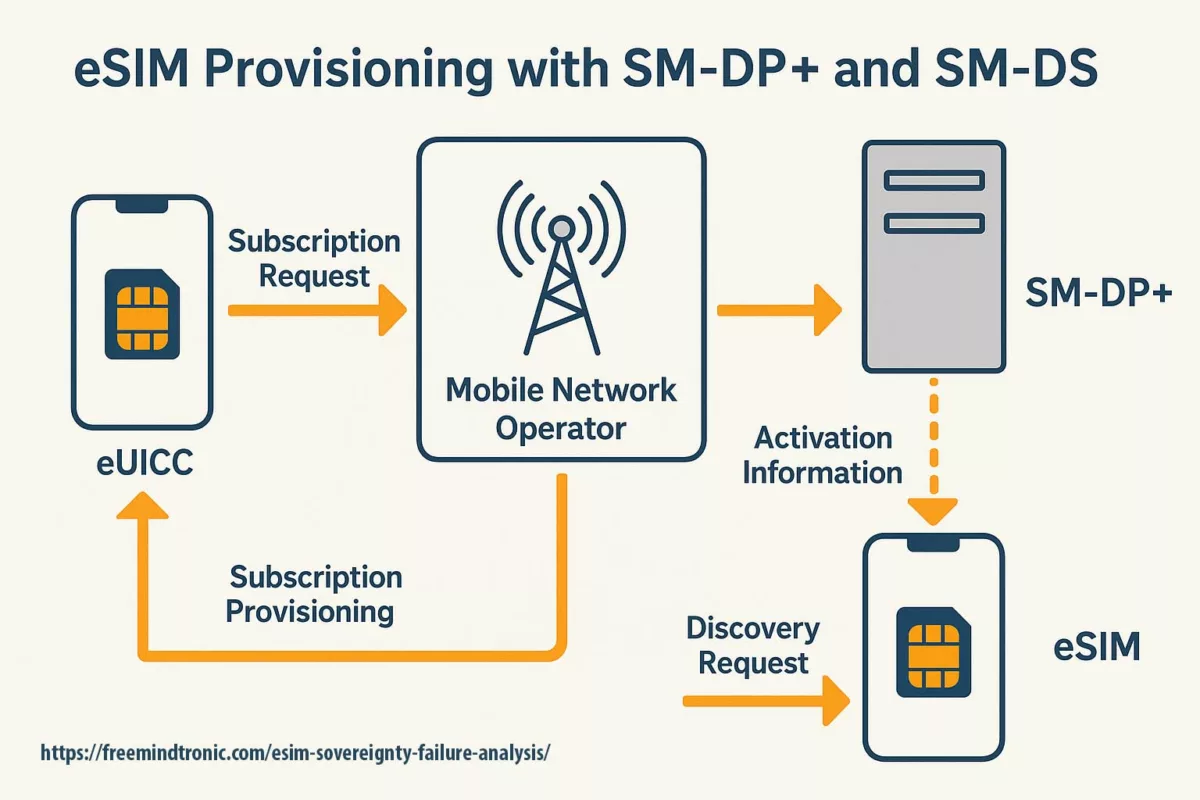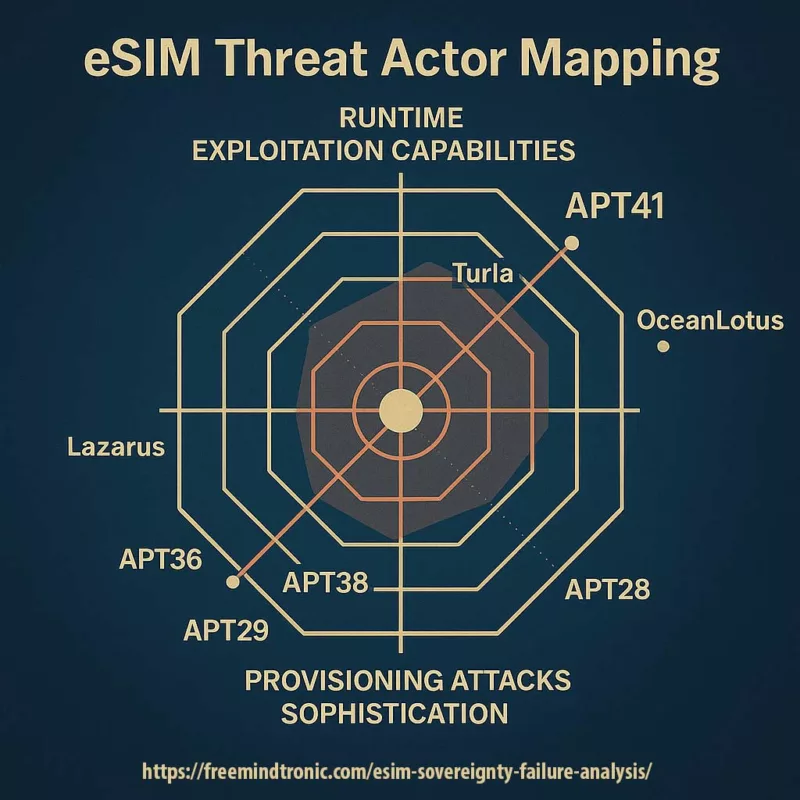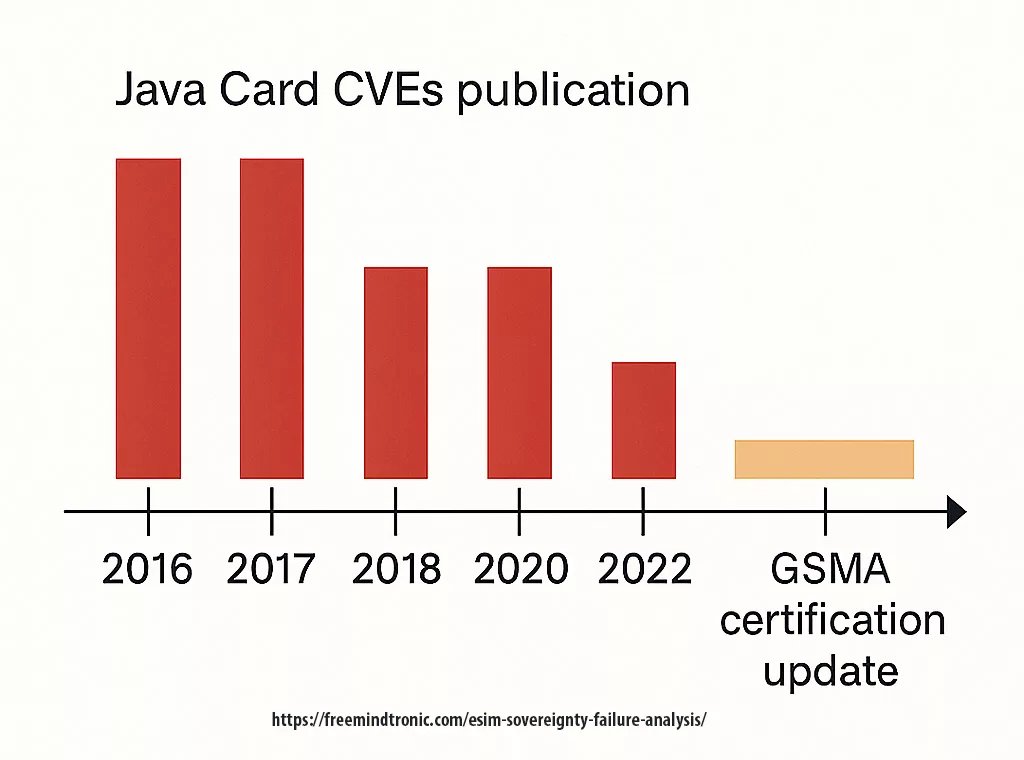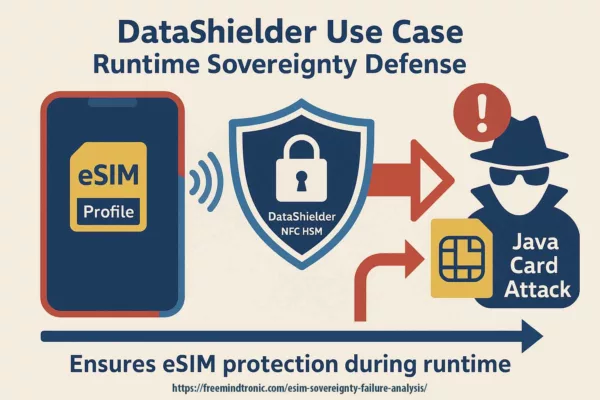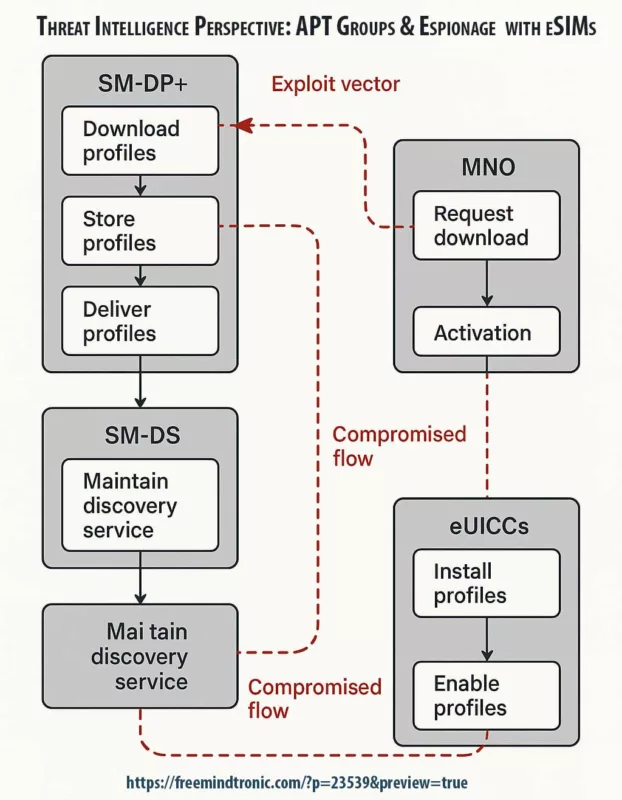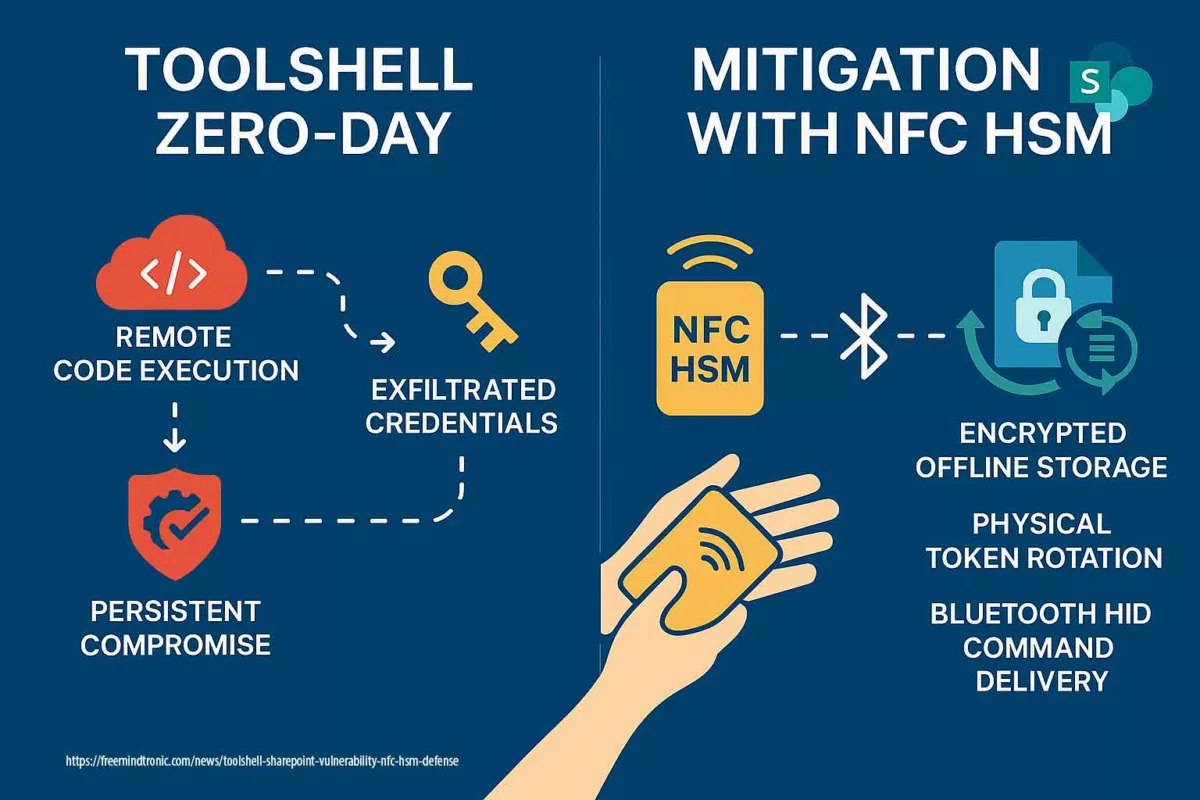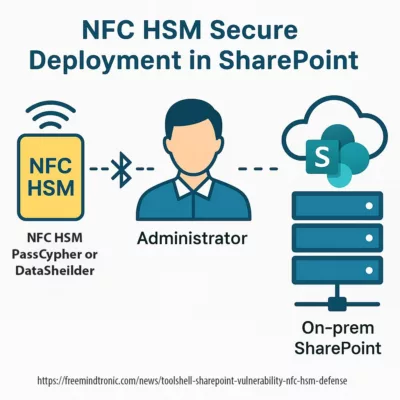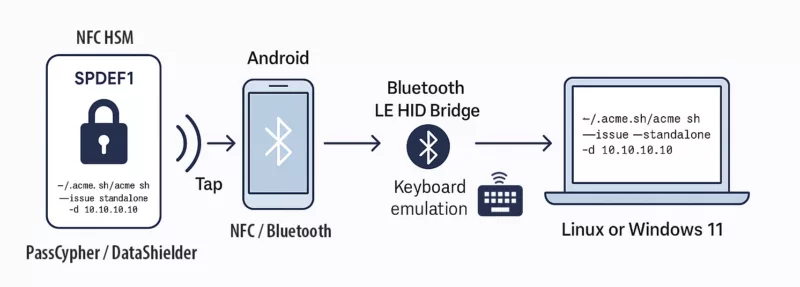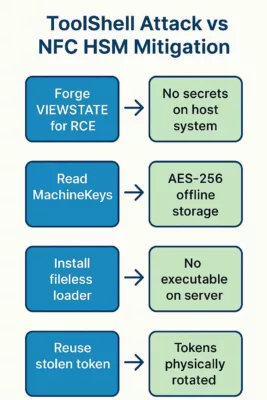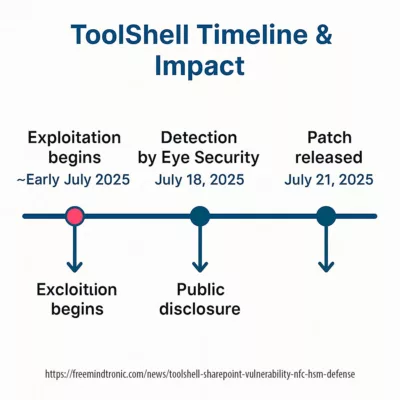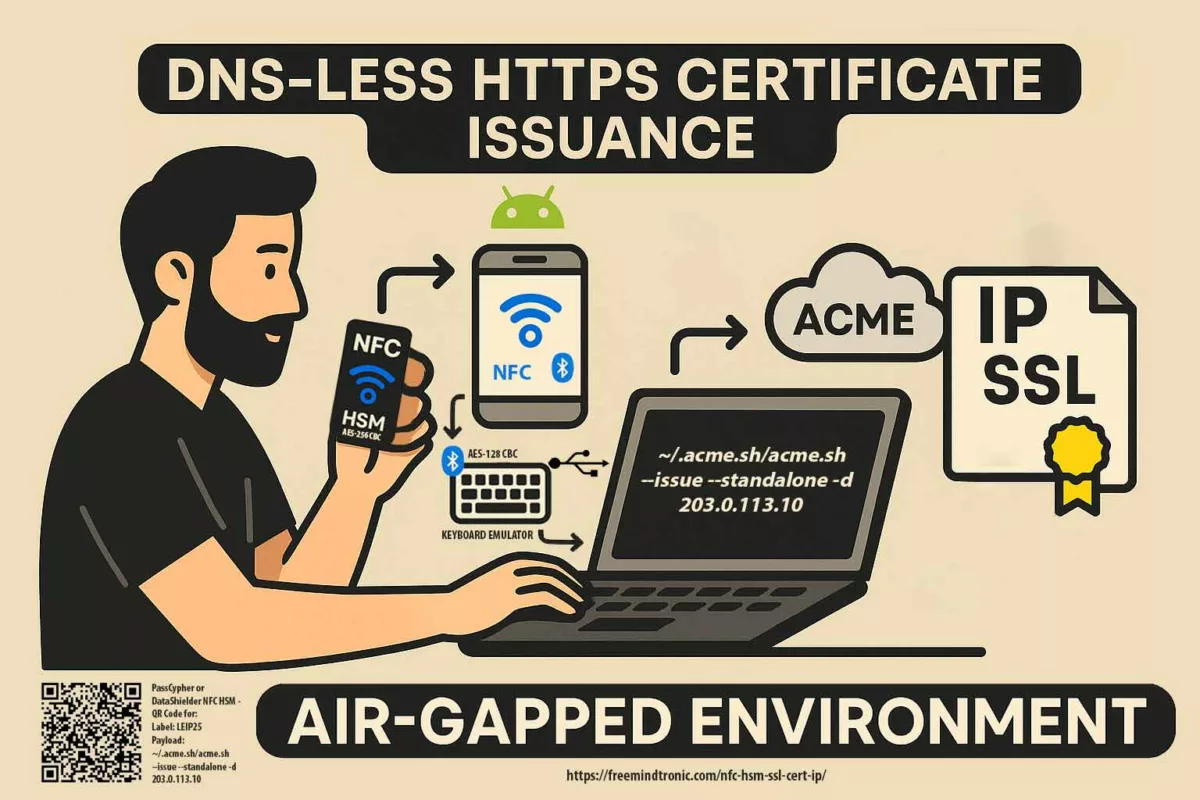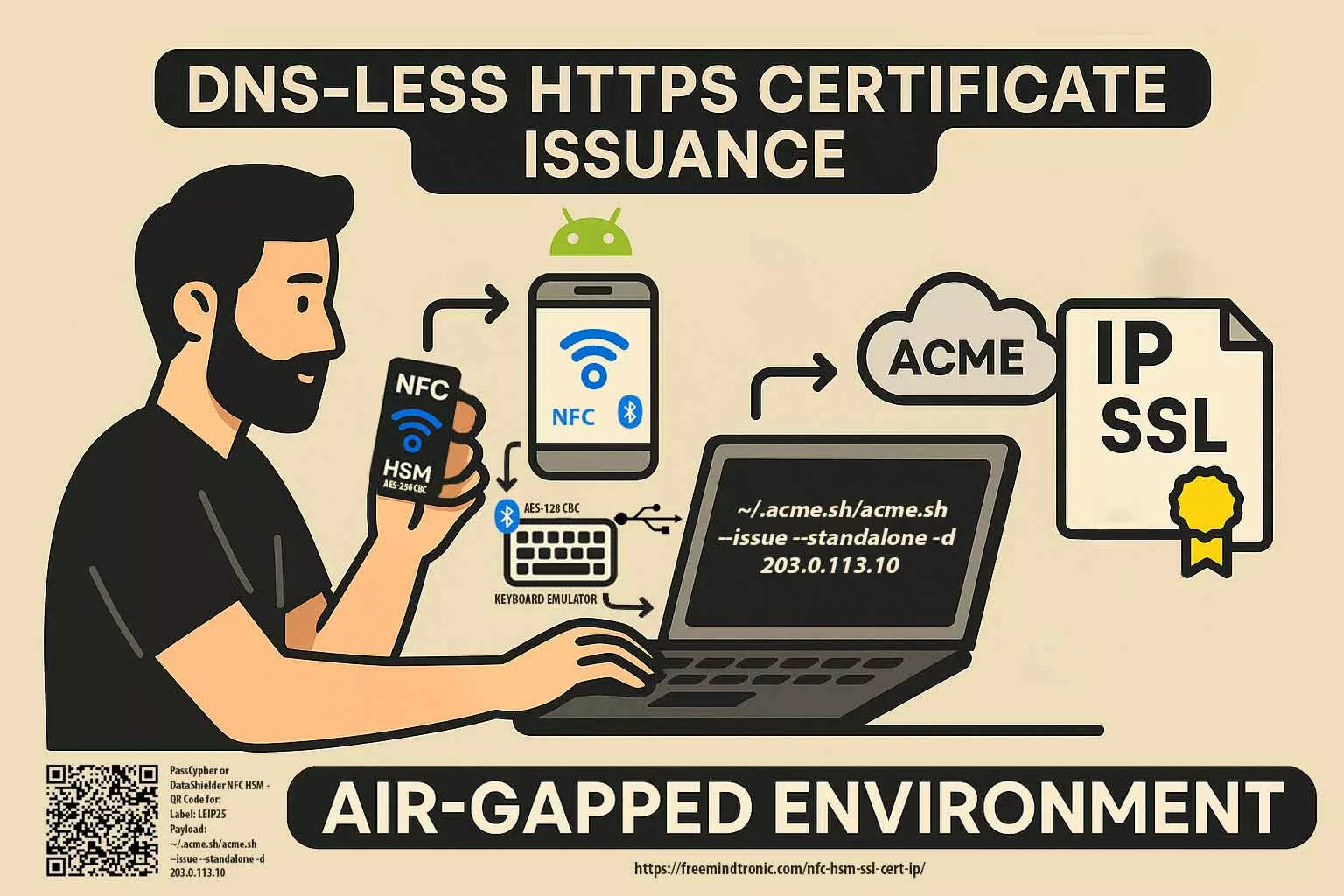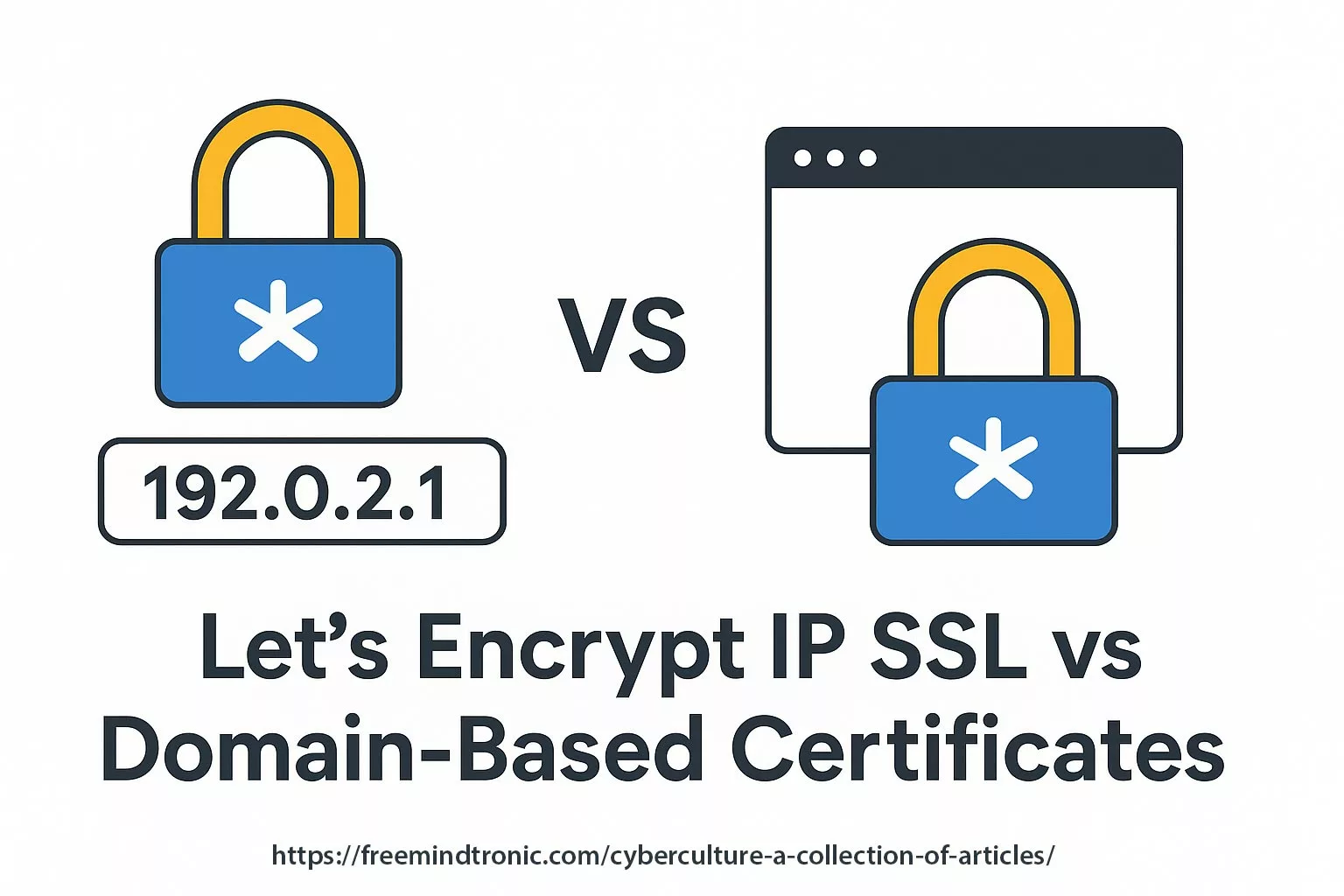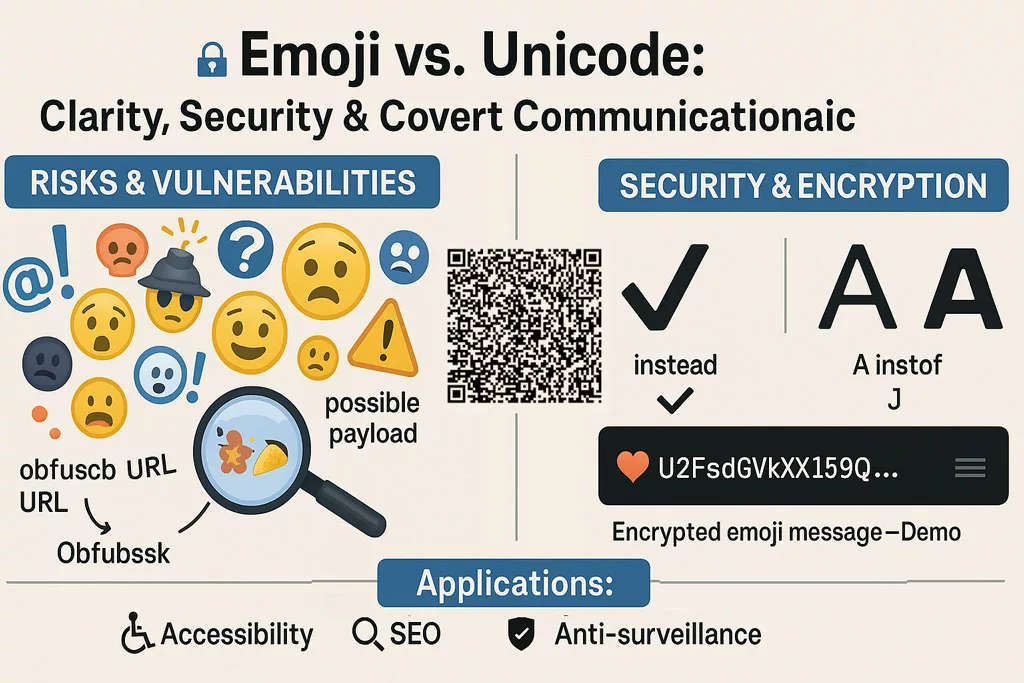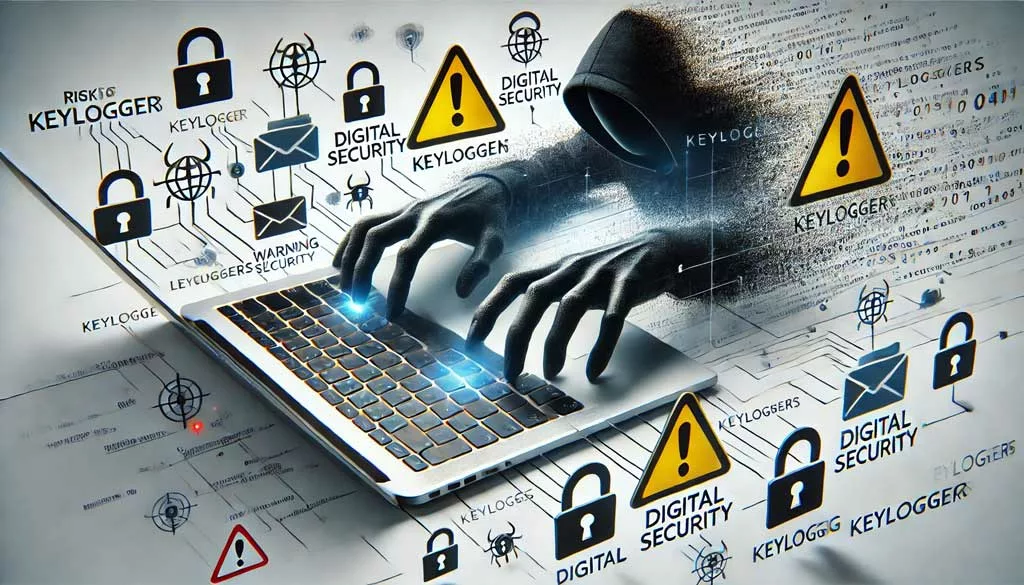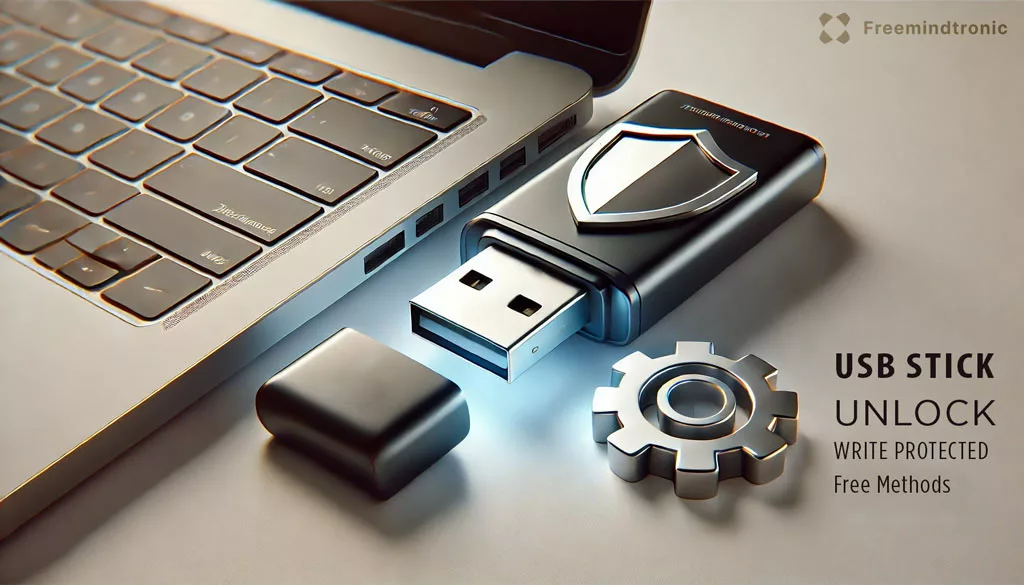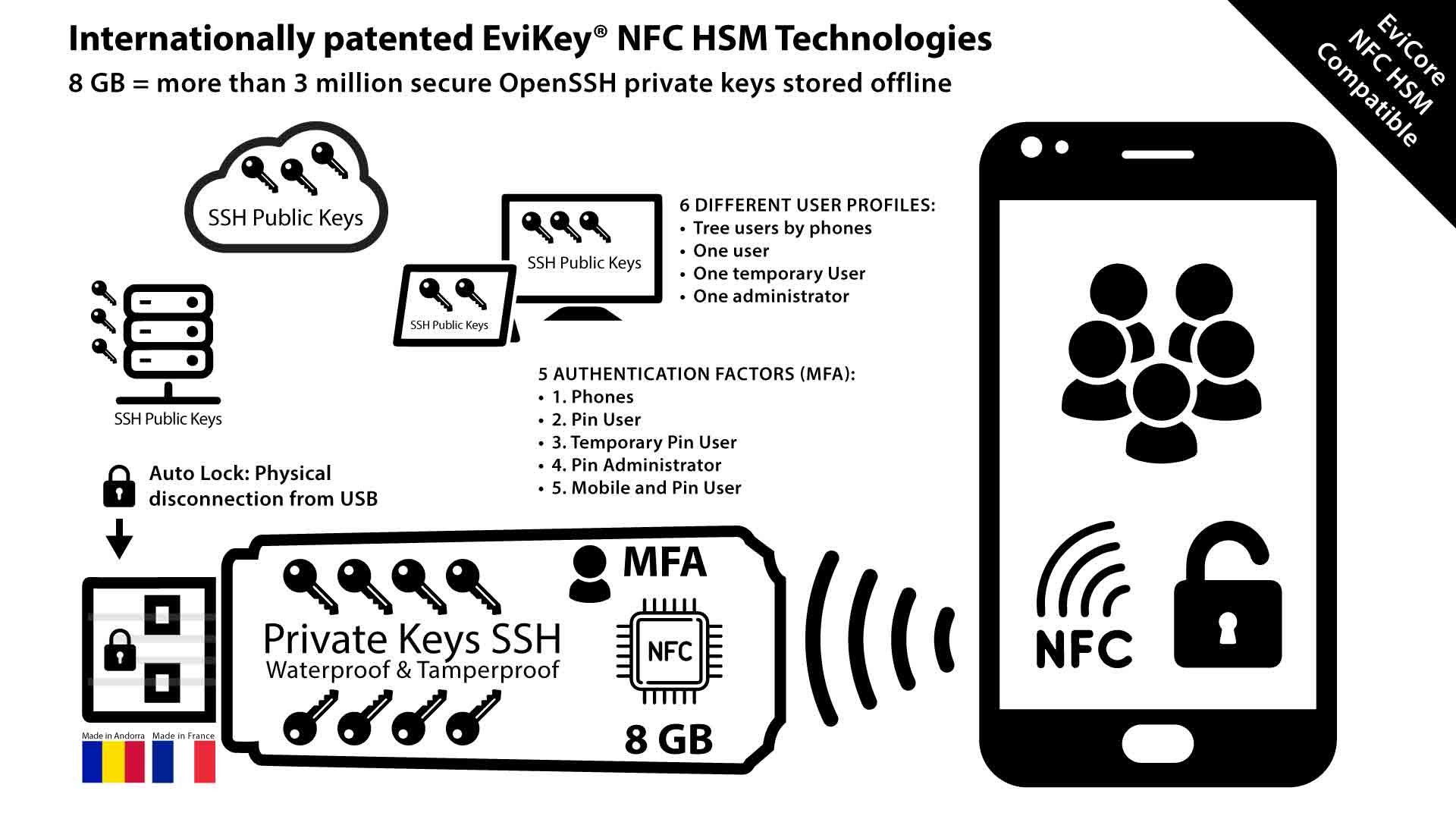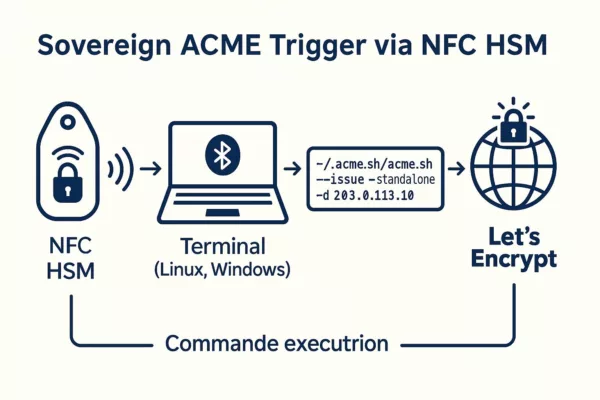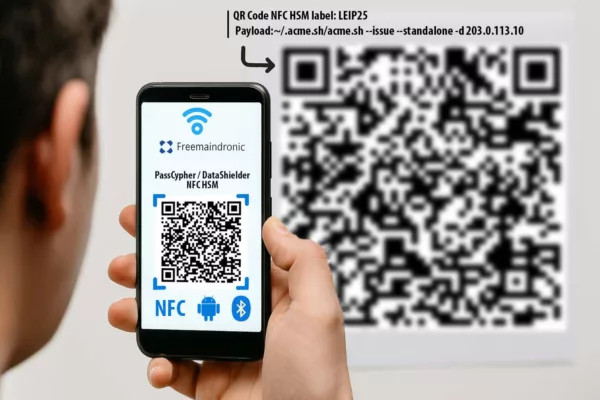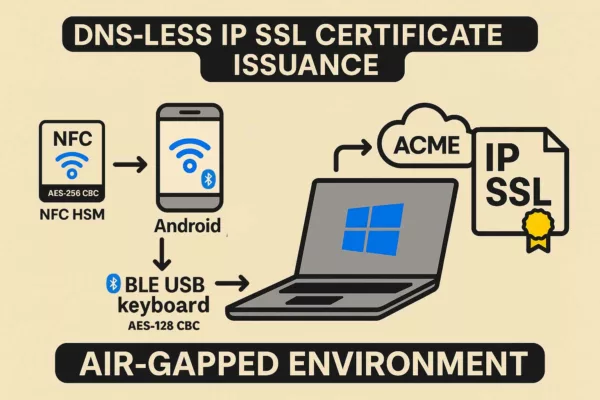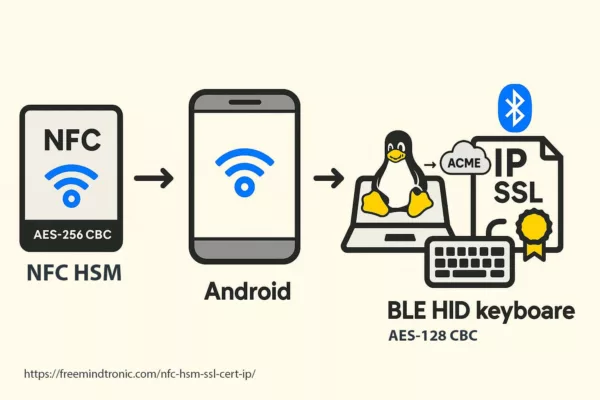Resumen Ejecutivo — Clickjacking Extensiones DOM
⮞ Nota de lectura
Si solo quieres lo esencial, este Resumen Ejecutivo (≈4 minutos) ofrece una visión sólida. Sin embargo, para una comprensión técnica completa, continúa con la crónica íntegra (≈36–38 minutos).
⚡ El Descubrimiento
Las Vegas, principios de agosto de 2025. DEF CON 33 ocupa el Centro de Convenciones de Las Vegas. Entre domos hacker, aldeas IoT, Adversary Village y competiciones CTF, el ambiente se electrifica. En el escenario, Marek Tóth conecta su portátil, inicia la demo y pulsa Enter.
De inmediato emerge el ataque estrella: clickjacking extensiones DOM. Fácil de codificar pero devastador al ejecutarse, se basa en una página trampa, iframes invisibles y una llamada maliciosa a focus(). Estos elementos engañan a los gestores de autocompletado para volcar credenciales, códigos TOTP y llaves de acceso (passkeys) en un formulario fantasma. Así, el clickjacking basado en DOM se manifiesta como una amenaza estructural.
✦ Impacto Inmediato en Gestores de Contraseñas
Los resultados son contundentes. Marek Tóth probó 11 gestores de contraseñas y todos mostraron vulnerabilidades de diseño. De hecho, 10 de 11 filtraron credenciales y secretos. Según SecurityWeek, casi 40 millones de instalaciones permanecen expuestas. Además, la ola se extiende más allá de los gestores: incluso las billeteras cripto (crypto-wallets) filtraron claves privadas “como un grifo que gotea”, exponiendo directamente activos financieros.
✦ Impacto inmediato en gestores de contraseñas
Los resultados son contundentes. Marek Tóth analizó 11 gestores de contraseñas: todos presentaban vulnerabilidades estructurales.
En 10 de ellos, se filtraron credenciales y secretos.
Según SecurityWeek, cerca de 40 millones de instalaciones siguen expuestas.
La amenaza se extiende más allá: incluso los monederos cripto filtraron claves privadas, exponiendo directamente activos financieros.
⧉ Segunda demostración ⟶ Exfiltración de passkeys vía overlay en DEF CON 33
Durante DEF CON 33, una segunda demostración independiente reveló que las passkeys «resistentes al phishing» pueden ser exfiltradas silenciosamente mediante una superposición visual y una redirección maliciosa — sin necesidad de inyección DOM. El ataque explota la confianza del usuario en interfaces conocidas y validaciones desde el navegador. Incluso FIDO/WebAuthn puede ser vulnerado en entornos no soberanos.
- Demostración oficial: yourpasskeyisweak.com
- Confirmación en prensa: MENAFN / PR Newswire
- Presentación técnica: Passkeys Pwned — DEF CON 33
- Análisis doctrinal: Passkeys vulnerables en DEF CON 33
⚠ Mensaje Estratégico — Riesgos Sistémicos
Con solo dos demostraciones — una contra gestores y billeteras, otra contra passkeys — colapsaron dos pilares de la ciberseguridad. El mensaje es claro: mientras los secretos residan en el DOM, seguirán siendo vulnerables. Además, mientras la seguridad dependa del navegador y la nube, un solo clic puede derrumbarlo todo.
Como recuerda OWASP, el clickjacking siempre ha sido una amenaza conocida. Sin embargo, aquí colapsa la propia capa de extensión.
⎔ La Alternativa Soberana — Contramedidas Zero-DOM
Afortunadamente, existe desde hace más de una década otra vía que no depende del DOM.
Con PassCypher HSM PGP, PassCypher NFC HSM y SeedNFC para respaldo hardware de claves criptográficas, tus credenciales, contraseñas y secretos TOTP/HOTP nunca tocan el DOM.
En cambio, permanecen cifrados en HSM fuera de línea (offline), inyectados de forma segura mediante sandboxing de URL o introducidos manualmente vía aplicación NFC en Android, siempre protegidos por defensas anti-BITB.
Por tanto, no es un parche, sino una arquitectura soberana sin contraseñas, patentada: descentralizada, sin servidor, sin base de datos central y sin contraseña maestra. Libera la gestión de secretos de dependencias centralizadas como FIDO/WebAuthn.
Crónica para leer
Tiempo estimado de lectura: 36–38 minutos
Fecha de actualización: 2025-09-11
Nivel de complejidad: Avanzado / Experto
Especificidad lingüística: Léxico soberano — alta densidad técnica
Idiomas disponibles: CAT · EN · ES · FR
Accesibilidad: Optimizado para lectores de pantalla — anclas semánticas incluidas
Tipo editorial: Crónica estratégica
Sobre el autor: Escrito por Jacques Gascuel, inventor y fundador de Freemindtronic®.
Especialista en tecnologías de seguridad soberana, diseña y patenta sistemas hardware para protección de datos, soberanía criptográfica y comunicaciones seguras. Además, su experiencia abarca el cumplimiento con ANSSI, NIS2, GDPR y SecNumCloud, así como la defensa frente a amenazas híbridas mediante arquitecturas soberanas por diseño.
En DEF CON 33, el clickjacking de extensiones DOM evidenció un riesgo sistémico para la seguridad de los navegadores y los gestores de contraseñas.
Datos expuestos: credenciales, códigos TOTP, passkeys y claves criptográficas.
Técnicas aplicadas: iframes invisibles, manipulación del Shadow DOM y superposiciones tipo Browser-in-the-Browser.
Impacto inicial: unas 40 millones de instalaciones reportadas como expuestas.
Estado al 11 de septiembre de 2025: varios proveedores publicaron parches para los métodos descritos (Bitwarden, Dashlane, Enpass, NordPass, ProtonPass, RoboForm, Keeper [parcial], LogMeOnce), mientras que otros siguen siendo vulnerables (1Password, iCloud Passwords, LastPass, KeePassXC-Browser).
En consecuencia: solo una arquitectura Zero-DOM con cifrado de hardware soberano elimina de forma sostenible la superficie de ataque y protege las credenciales frente a este tipo de ataques.
Anatomía del clickjacking extensiones DOM: una página maliciosa, un iframe oculto y un secuestro de autocompletado que exfiltra credenciales, llaves de acceso y claves de billeteras cripto.
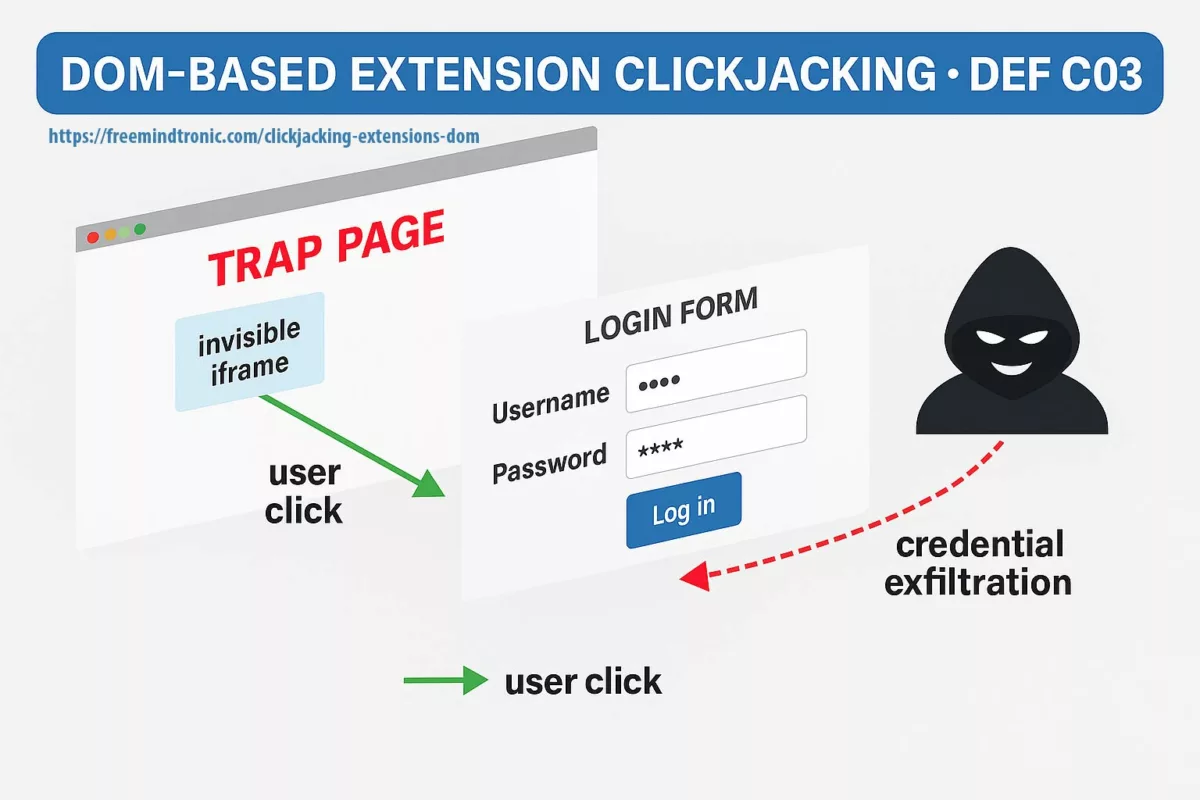
En ciberseguridad soberana ↑ Esta crónica forma parte de la sección Seguridad Digital, continuando nuestra investigación sobre exploits, vulnerabilidades sistémicas y contramedidas de confianza cero basadas en hardware.
- Executive Summary
- History of Clickjacking (2002–2025)
- What is DOM-Based Extension Clickjacking?
- Vulnerable Password Managers
- CVE Disclosure & Vendor Responses
- Technologies of Correction Used
- Correction Technologies — Technical & Doctrinal Analysis
- Systemic Risks & Exploitation Vectors
- Regional Exposure & Linguistic Impact
- Exposed Crypto Wallet Extensions
- Browser Sandbox Weakness & Browser-in-the-Browser (BITB)
- Strategic Signals from DEF CON 33
- Sovereign Countermeasures (Zero DOM)
- PassCypher HSM PGP — Patented Zero-DOM Technology
- PassCypher NFC HSM — Passwordless Sovereign Manager
- SeedNFC + HID Bluetooth — Secure Wallet Injection
- Future Exploitation Scenarios & Mitigation
- Strategic Synthesis
- Glosario
Key Points:
- 11 password managers proved vulnerable — credentials, TOTP, and passkeys were exfiltrated through DOM redressing.
- Popular crypto-wallet extensions (MetaMask, Phantom, TrustWallet) face the same DOM extension clickjacking risks.
- Exploitation requires only a single click, leveraging hidden iframes, encapsulated Shadow DOM, and Browser-in-the-Browser overlays.
- The browser sandbox is no sovereign stronghold — BITB overlays can deceive user perception.
- PassCypher NFC / HSM PGP and SeedNFC provide hardware-based Zero-DOM flows anchored in secure enclaves, with integrated anti-BITB kill-switch.
- A decade of sovereign R&D anticipated these risks: segmented AES-256 containers, hybrid NFC↔PGP RAM channels, and HID injection form the native alternative.
¿Qué es el clickjacking de extensiones basado en el DOM?
DOM-based extension clickjacking secuestra una extensión del navegador (gestor de contraseñas o wallet) abusando del Document Object Model. Una página engañosa enlaza iframes invisibles, Shadow DOM y una llamada maliciosa a focus() para provocar el autocompletado en un formulario invisible. La extensión «cree» que está en el campo correcto y vierte secretos allí — credenciales, códigos TOTP/HOTP, passkeys, incluso claves privadas. Porque estos secretos tocan el DOM, pueden ser exfiltrados de forma silenciosa.
¿Qué nivel de peligrosidad tiene?
Este vector no es menor: explota la propia lógica del autocompletado y opera sin que el usuario lo note. El atacante no se limita a superponer un elemento; fuerza a la extensión a rellenar un formulario falso como si nada, haciendo la exfiltración indetectable a simple vista.
Flujo típico del ataque
- Preparación — la página maliciosa incrusta un
iframeinvisible y un Shadow DOM que oculta el contexto real; los campos se hacen no visibles (opacity:0,pointer-events:none). - Cebo — la víctima hace clic en un elemento inocuo; redirecciones y un
focus()malicioso redirigen el evento a un campo controlado por el atacante. - Exfiltración — la extensión cree que interactúa con un campo legítimo e inyecta automáticamente credenciales, TOTP, passkeys o claves privadas en el DOM falso; los datos se exfiltran al instante.
Este mecanismo engaña las señales visuales, elude protecciones clásicas (X-Frame-Options, Content-Security-Policy, frame-ancestors) y convierte el autocompletado en un canal de exfiltración invisible. Los overlays tipo Browser-in-the-Browser (BITB) y la manipulación del Shadow DOM aumentan aún más el riesgo, haciendo phishable las passkeys sincronizadas y las credenciales.
⮞ Resumen
El ataque combina iframes invisibles, manipulación del Shadow DOM y redirecciones vía focus() para secuestrar extensiones de autofill. Los secretos se inyectan en un formulario fantasma, dando al atacante acceso directo a datos sensibles (credenciales, TOTP/HOTP, passkeys, claves privadas). Conclusión: mientras los secretos transiten por el DOM, la superficie de ataque permanece abierta.
Historia del Clickjacking (2002–2025)
El clickjacking se ha convertido en el parásito persistente de la web moderna. El término surgió a principios de los 2000, cuando Jeremiah Grossman y Robert Hansen describieron un escenario engañoso: inducir al usuario a hacer clic en algo que en realidad no podía ver. Una ilusión óptica aplicada al código, pronto se convirtió en una técnica de ataque de referencia (OWASP).
- 2002–2008: Aparición del “UI redressing”: capas HTML + iframes transparentes atrapando al usuario (Archivo Hansen).
- 2009: Facebook cae víctima del Likejacking (OWASP).
- 2010: Surge el Cursorjacking — desplazar el puntero para manipular clics (OWASP).
- 2012–2015: Explotación vía iframes, anuncios online y malvertising (MITRE CVE) (Infosec).
- 2016–2019: El tapjacking se extiende en móviles Android (Android Security Bulletin).
- 2020–2024: Auge del “clickjacking híbrido” combinando XSS y phishing (OWASP WSTG).
- 2025: En DEF CON 33, Marek Tóth presenta un nuevo nivel: Clickjacking de Extensiones DOM. Esta vez no solo los sitios web, sino también las extensiones del navegador (gestores de contraseñas, billeteras cripto) inyectan formularios invisibles, habilitando la exfiltración sigilosa de secretos.
En DEF CON 33, Tóth reveló públicamente el clickjacking de extensiones DOM, marcando un cambio estructural: de un truco visual a una debilidad sistémica en gestores de contraseñas y wallets cripto.
❓¿Cuánto tiempo llevas expuesto?
Los fabricantes de gestores de contraseñas tuvieron todas las señales de advertencia.
OWASP documenta el clickjacking desde 2002, los iframes invisibles son conocidos desde hace más de 15 años, y el Shadow DOM nunca fue un secreto esotérico.
En resumen: todos lo sabían.
Y aun así, la mayoría siguió construyendo castillos de arena sobre el autocompletado DOM. ¿Por qué? Porque se veía impecable en las presentaciones de marketing: UX fluida, inicios de sesión mágicos con un clic, adopción masiva… con la seguridad relegada a un segundo plano.
El clickjacking extensiones DOM revelado en DEF CON 33 no es un hallazgo nuevo de 2025. Es el resultado de un defecto de diseño de más de una década. Toda extensión que “confiaba en el DOM” para inyectar accesos, TOTP o passkeys ya era vulnerable.
⮞ Reflexión crítica: ¿cuánto tiempo han explotado esto en silencio?
La verdadera cuestión es: ¿durante cuánto tiempo explotaron en silencio estas vulnerabilidades atacantes discretos — mediante espionaje dirigido, robo de identidad o sifoneo de wallets cripto?
Mientras los gestores software miraban hacia otro lado, PassCypher y SeedNFC de Freemindtronic Andorra optaron por otro camino. Diseñados fuera del DOM, fuera de la nube y sin contraseña maestra, demostraron que ya existía una alternativa soberana: la seguridad por diseño.
Resultado: una década de exposición silenciosa para algunos, y una década de ventaja tecnológica para quienes invirtieron en hardware soberano.
En apenas 20 años, el clickjacking pasó de ser un simple truco visual a un sabotaje sistémico de gestores de identidad. DEF CON 33 marca un punto de ruptura: la amenaza ya no son solo sitios web maliciosos, sino el núcleo mismo de las extensiones de navegador y el autocompletado. De ahí la urgencia de enfoques Zero-DOM anclados en hardware soberano como PassCypher.
Vulnerabilidades de Gestores de Contraseñas & divulgación CVE (instantánea — 2 oct. 2025)
Actualización: 2 de octubre de 2025 Tras la divulgación en DEF CON 33 por Marek Tóth, varios proveedores publicaron correcciones o mitigaciones, pero la velocidad de respuesta varía considerablemente. La nueva columna indica el tiempo estimado entre la presentación (8 de agosto de 2025) y la publicación de un parche/mitigación.
| Gestor | Credenciales | TOTP | Passkeys | Estado | Parche / nota oficial | ⏱️ Tiempo de parche |
|---|---|---|---|---|---|---|
| 1Password | Sí | Sí | Sí | Mitigaciones (v8.11.x) | Blog | 🟠 >6 semanas (mitigación) |
| Bitwarden | Sí | Sí | Parcial | Corregido (v2025.8.2) | Release | 🟢 ~4 semanas |
| Dashlane | Sí | Sí | Sí | Corregido | Advisory | 🟢 ~3 semanas |
| LastPass | Sí | Sí | Sí | Corregido (sept. 2025) | Release | 🟠 ~6 semanas |
| Enpass | Sí | Sí | Sí | Corregido (v6.11.6) | Release | 🟠 ~5 semanas |
| iCloud Passwords | Sí | No | Sí | Vulnerable (en examen) | – | 🔴 >7 semanas (sin parche) |
| LogMeOnce | Sí | No | Sí | Corregido (v7.12.7) | Release | 🟢 ~4 semanas |
| NordPass | Sí | Sí | Parcial | Corregido (atenuaciones) | Release | 🟠 ~5 semanas |
| ProtonPass | Sí | Sí | Parcial | Corregido (atenuaciones) | Releases | 🟠 ~5 semanas |
| RoboForm | Sí | Sí | Sí | Corregido | Update | 🟢 ~4 semanas |
| Keeper | Parcial | No | No | Parche parcial (v17.2.0) | Release | 🟠 ~6 semanas (parcial) |
Zero-DOM, superficie de ataque nula.
Divulgación CVE y Respuestas de Proveedores (Ago–Sep 2025)
El descubrimiento de Marek Tóth en DEF CON 33 no podía permanecer oculto: las vulnerabilidades de clickjacking extensiones DOM están recibiendo actualmente identificadores oficiales CVE.
Sin embargo, como suele ocurrir en los procesos de vulnerability disclosure, el avance es lento. Varias fallas fueron reportadas ya en primavera de 2025, pero a mediados de agosto algunos proveedores aún no habían publicado correcciones públicas.
Respuestas de proveedores y cronología de parches:
- Bitwarden — reaccionó rápidamente con el parche
v2025.8.0(agosto 2025), mitigando fugas de credenciales y TOTP. - Dashlane — lanzó una corrección (
v6.2531.1, inicios de agosto 2025), confirmada en notas oficiales. - RoboForm — desplegó parches en julio–agosto 2025 en versiones Windows y macOS.
- NordPass y ProtonPass — anunciaron actualizaciones oficiales en agosto 2025, mitigando parcialmente la exfiltración vía DOM.
- Keeper — reconoció el impacto, pero sigue en estado “en revisión” sin parche confirmado.
- 1Password, LastPass, Enpass, iCloud Passwords, LogMeOnce — permanecen sin parche a inicios de septiembre 2025, dejando usuarios expuestos.
El problema no es solo el retraso en los parches, sino también la manera en que algunos proveedores minimizaron el fallo. Según informes de seguridad, ciertos editores inicialmente catalogaron la vulnerabilidad como “informativa”, restándole gravedad.
En otras palabras: reconocieron la fuga, pero la relegaron a una “caja gris” hasta que la presión mediática y comunitaria los obligó a actuar.
⮞ Resumen
Los CVE de clickjacking extensiones DOM siguen en proceso.
Mientras proveedores como Bitwarden, Dashlane, NordPass, ProtonPass y RoboForm publicaron parches oficiales en agosto–septiembre 2025, otros (1Password, LastPass, Enpass, iCloud Passwords, LogMeOnce) siguen rezagados, dejando a millones de usuarios expuestos.
Algunas compañías incluso optaron por el silencio en lugar de la transparencia, tratando un exploit estructural como un problema menor hasta que la presión externa los obligó a reaccionar.
Tecnologías de Corrección Utilizadas
Desde la divulgación pública del clickjacking extensiones DOM en DEF CON 33, los proveedores se apresuraron a lanzar parches. Sin embargo, estas correcciones siguen siendo desiguales, limitadas en su mayoría a ajustes de interfaz o comprobaciones condicionales. Ningún proveedor ha re-ingenierizado aún el motor de inyección en sí.
🔍 Antes de profundizar en los métodos de corrección, aquí tienes una vista general de las principales tecnologías desplegadas por los proveedores para mitigar el clickjacking de extensiones DOM. La infografía muestra el espectro: desde parches cosméticos hasta soluciones soberanas Zero-DOM.
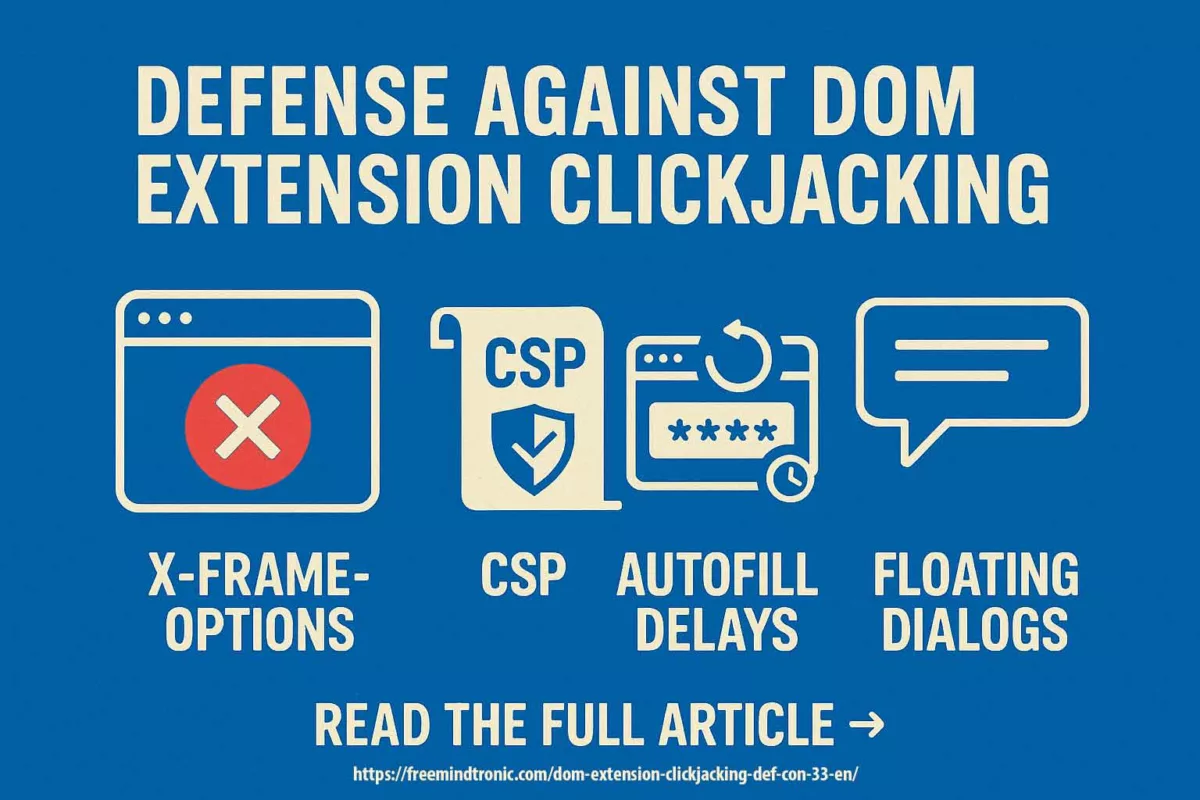
Objetivo
Esta sección explica cómo intentaron los proveedores corregir la falla, distingue entre parches cosméticos y correcciones estructurales, y destaca las aproximaciones soberanas Zero-DOM en hardware.
Métodos de Corrección Observados (agosto 2025)
| Método | Descripción | Gestores afectados |
|---|---|---|
| Restricción de Autocompletado | Cambio a modo “on-click” o desactivación por defecto | Bitwarden, Dashlane, Keeper |
| Filtrado de Subdominios | Bloquear autocompletado en subdominios no autorizados | ProtonPass, RoboForm |
| Detección de Shadow DOM | Rechazo de inyección si el campo está encapsulado en Shadow DOM | NordPass, Enpass |
| Aislamiento Contextual | Comprobaciones previas a la inyección (iframe, opacidad, foco) | Bitwarden, ProtonPass |
| Hardware Soberano (Zero-DOM) | Los secretos nunca transitan por el DOM: NFC HSM, HSM PGP, SeedNFC | PassCypher, EviKey, SeedNFC (no vulnerables por diseño) |
📉 Límites Observados
- Los parches no modificaron el motor de inyección, solo sus disparadores de activación.
- Ningún proveedor introdujo separación estructural entre interfaz y flujo de secretos.
- Cualquier gestor aún atado al DOM permanece expuesto estructuralmente a variantes de clickjacking.
⮞ Transición estratégica:
Estos parches muestran reacción, no ruptura. Abordan síntomas, no la falla estructural.
Para entender qué separa un parche temporal de una corrección doctrinal, avancemos al siguiente análisis.
Tecnologías de Corrección frente al Clickjacking de Extensiones DOM — Análisis Técnico y Doctrinal
📌 Observación
El clickjacking extensiones DOM no es un simple bug, sino un defecto de diseño: inyectar secretos en un DOM manipulable sin separación estructural ni verificación contextual.
⚠️ Lo que las correcciones actuales no abordan
- Ningún proveedor ha reconstruido su motor de inyección.
- Las correcciones se limitan a desactivar autocompletado, filtrar subdominios o detectar elementos invisibles.
- Ninguno ha integrado una arquitectura Zero-DOM que garantice inviolabilidad por diseño.
🧠 Lo que requeriría una corrección estructural
- Eliminar toda dependencia del DOM para la inyección de secretos.
- Aislar el motor de inyección fuera del navegador.
- Usar autenticación hardware (NFC, PGP, biometría).
- Registrar cada inyección en un diario auditable.
- Prohibir interacción con elementos invisibles o encapsulados.
📊 Tipología de correcciones
| Nivel | Tipo de corrección | Descripción |
|---|---|---|
| Cosmética | UI/UX, autocompletado desactivado por defecto | No cambia la lógica de inyección, solo el disparador |
| Contextual | Filtrado DOM, Shadow DOM, subdominios | Agrega condiciones, pero sigue dependiendo del DOM |
| Estructural | Zero-DOM, basado en hardware (PGP, NFC, HSM) | Elimina el uso del DOM para secretos, separa interfaz y flujos críticos |
🧪 Pruebas doctrinales para verificar parches
Para comprobar si la corrección de un proveedor es realmente estructural, los investigadores de seguridad pueden:
- Inyectar un campo invisible (
opacity:0) dentro de un iframe. - Simular un Shadow DOM encapsulado.
- Verificar si la extensión aún inyecta secretos.
- Comprobar si la inyección queda registrada o bloqueada.
📜 Ausencia de estándar industrial
Actualmente, no existe ningún estándar oficial (NIST, OWASP, ISO) que regule:
- La lógica de inyección en extensiones,
- La separación entre interfaz y flujo de secretos,
- La trazabilidad de acciones de autocompletado.
⮞ Transición doctrinal
Los parches actuales son curitas temporales.
Solo las arquitecturas soberanas Zero-DOM — PassCypher HSM PGP, PassCypher NFC HSM, SeedNFC — representan una corrección estructural y doctrinal.
El camino no es el tuning software, sino la doctrina del hardware soberano.
Riesgos Sistémicos y Vectores de Explotación
El clickjacking extensiones DOM no es un fallo aislado, sino una vulnerabilidad sistémica. Cuando una extensión del navegador se derrumba, las consecuencias no se limitan a una contraseña filtrada. En cambio, socava todo el modelo de confianza digital, provocando brechas en cascada a través de capas de autenticación e infraestructuras.
Escenarios críticos:
- Acceso persistente — Un TOTP clonado basta para registrar un “dispositivo de confianza” y mantener acceso incluso tras un restablecimiento completo de la cuenta.
- Reutilización de passkeys — La exfiltración de una llave de acceso actúa como un token maestro, reutilizable fuera de cualquier perímetro de control. El “Zero Trust” se convierte en ilusión.
- Compromiso SSO — Una extensión atrapada en una empresa conduce a la fuga de tokens OAuth/SAML, comprometiendo todo el sistema de TI.
- Brecha en la cadena de suministro — Extensiones mal reguladas crean una superficie de ataque estructural a nivel de navegador.
- Sifoneo de criptoactivos — Billeteras como MetaMask, Phantom o TrustWallet inyectan claves en el DOM; frases semilla y claves privadas son drenadas tan fácilmente como credenciales.
⮞ Resumen
Los riesgos van mucho más allá del robo de contraseñas: TOTPs clonados, passkeys reutilizados, tokens SSO comprometidos y frases semilla exfiltradas.
Mientras el DOM siga siendo la interfaz de autocompletado, seguirá siendo también la interfaz de exfiltración encubierta.
Comparativa de Amenazas y Contramedidas Soberanas
| Ataque | Objetivo | Secretos en Riesgo | Contramedida Soberana |
|---|---|---|---|
| ToolShell RCE | SharePoint / OAuth | Certificados SSL, tokens SSO | PassCypher HSM PGP (almacenamiento + firma fuera del DOM) |
| Secuestro de eSIM | Identidad móvil | Perfiles de operador, SIM embebida | SeedNFC HSM (anclaje hardware de identidades móviles) |
| Clickjacking DOM | Extensiones de navegador | Credenciales, TOTP, passkeys | PassCypher NFC HSM + PassCypher HSM PGP (OTP seguro, autocompletado en sandbox, anti-BITB) |
| Secuestro de wallets cripto | Extensiones de billetera | Claves privadas, frases semilla | SeedNFC HSM + acoplamiento NFC↔HID BLE (inyección hardware multiplataforma segura) |
| Atomic Stealer | Portapapeles macOS | Llaves PGP, wallets cripto | PassCypher NFC HSM ↔ HID BLE (canales cifrados, inyección sin portapapeles) |
Exposición Regional e Impacto Lingüístico — Mundo Anglófono
No todas las regiones comparten el mismo nivel de riesgo frente al clickjacking extensiones DOM y a los ataques Browser-in-the-Browser (BITB). La esfera anglófona —debido a la alta adopción de gestores de contraseñas y billeteras cripto— representa una base de usuarios significativamente más expuesta. Por tanto, las contramedidas soberanas Zero-DOM son críticas para proteger a esta región digitalmente dependiente.
🌍 Exposición estimada — Región Anglófona (ago 2025)
| Región | Usuarios anglófonos estimados | Adopción de gestores | Contramedidas Zero-DOM |
|---|---|---|---|
| Hablantes globales de inglés | ≈1.5 mil millones | Alta (Norteamérica, Reino Unido, Australia) | PassCypher HSM PGP, SeedNFC |
| Norteamérica (EE.UU. + Canadá anglófono) | ≈94 millones (36 % de adultos en EE.UU.) | Conciencia creciente; adopción aún baja | PassCypher HSM PGP, NFC HSM |
| Reino Unido | Alta penetración de internet y wallets cripto | Adopción en maduración; regulaciones crecientes | PassCypher HSM PGP, EviBITB |
⮞ Perspectiva estratégica
El mundo anglófono representa una superficie de exposición inmensa: hasta 1.5 mil millones de hablantes de inglés en todo el mundo, con casi 100 millones de usuarios de gestores de contraseñas en Norteamérica.
Con el aumento de amenazas cibernéticas, estas poblaciones requieren soluciones soberanas Zero-DOM —como PassCypher HSM PGP, SeedNFC y EviBITB— para neutralizar fundamentalmente los riesgos basados en DOM.
Fuentes: ICLS (hablantes de inglés), Security.org (uso de gestores en EE.UU.), DataReportal (estadísticas digitales UK).
Extensiones de Billeteras Cripto Expuestas
Los gestores de contraseñas no son las únicas víctimas del clickjacking extensiones DOM.
Las billeteras cripto más utilizadas — MetaMask, Phantom, TrustWallet — dependen del mismo mecanismo de inyección DOM para mostrar o firmar transacciones.
En consecuencia, una superposición bien colocada o un iframe invisible engañan al usuario, haciéndole creer que aprueba una transacción legítima, cuando en realidad está autorizando una transferencia maliciosa o exponiendo su frase semilla.
Implicación directa: A diferencia de credenciales robadas o TOTP clonados, estas fugas afectan a activos financieros inmediatos. Miles de millones de dólares en valor líquido dependen de tales extensiones.
Por tanto, el DOM se convierte no solo en un vector de compromiso de identidad, sino también en un canal de exfiltración monetaria.
⮞ Resumen
Las extensiones de billeteras cripto reutilizan el DOM para la interacción con el usuario. Esta elección arquitectónica las expone a las mismas fallas que los gestores de contraseñas: frases semilla, claves privadas y firmas de transacciones pueden ser interceptadas mediante overlay redressing y secuestro de autocompletado.
Las claves nunca abandonan el HSM; cada operación requiere un disparador físico del usuario, anulando el redressing en DOM.De forma complementaria, PassCypher HSM PGP y PassCypher NFC HSM protegen OTPs y credenciales de acceso a plataformas de trading, evitando así compromisos laterales entre cuentas.
Sandbox Fallida y Browser-in-the-Browser (BITB)
Los navegadores presentan su sandbox como una fortaleza inexpugnable.
Sin embargo, los ataques de clickjacking extensiones DOM y Browser-in-the-Browser (BITB) demuestran lo contrario.
Una simple superposición y un marco de autenticación falso pueden engañar al usuario, haciéndole creer que interactúa con Google, Microsoft o su banco, cuando en realidad está entregando secretos a una página fraudulenta.
Incluso las directivas frame-ancestors y algunas políticas CSP fallan en prevenir estas ilusiones de interfaz.
Aquí es donde las tecnologías soberanas cambian la ecuación.
Con EviBITB (IRDR), Freemindtronic integra en PassCypher HSM PGP un motor de detección y destrucción de iframes maliciosos, neutralizando intentos BITB en tiempo real.
Activable con un solo clic, funciona en modo manual, semiautomático o automático, totalmente serverless y sin base de datos, garantizando defensa instantánea (explicación · guía detallada).
La piedra angular sigue siendo la Sandbox URL.
Cada identificador o clave criptográfica se vincula a una URL de referencia almacenada de forma segura en el HSM cifrado.
Cuando una página solicita autocompletado, la URL activa se compara con la referencia. Si no coincide, no se inyecta ningún dato.
Así, incluso si un iframe logra evadir la detección, la Sandbox URL bloquea los intentos de exfiltración.
Esta barrera de doble capa también se extiende al uso en escritorio.
Mediante el emparejamiento seguro NFC entre un smartphone Android y la aplicación Freemindtronic con PassCypher NFC HSM, los usuarios se benefician de protección anti-BITB en escritorio.
Los secretos permanecen cifrados dentro del HSM NFC y solo se descifran en memoria RAM durante unos milisegundos, lo justo para el autocompletado — nunca persisten en el DOM.
⮞ Resumen técnico (ataque neutralizado por EviBITB + Sandbox URL)
El clickjacking extensiones DOM explota superposiciones CSS invisibles (opacity:0, pointer-events:none) para redirigir clics a un campo oculto inyectado desde el Shadow DOM (ej. protonpass-root).
Mediante focus() y rastreo de cursor, la extensión activa el autocompletado, insertando credenciales, TOTP o passkeys en un formulario invisible que se exfiltra inmediatamente.
Con EviBITB (IRDR), estos iframes y overlays son destruidos en tiempo real, eliminando el vector malicioso.
La Sandbox URL valida el destino frente a la referencia cifrada en HSM (PassCypher HSM PGP o NFC HSM). Si no coincide, el autocompletado se bloquea.
Resultado: ningún clic atrapado, ninguna inyección, ninguna fuga.
Los secretos permanecen fuera del DOM, incluso en uso de escritorio vía emparejamiento NFC HSM con smartphone Android.

✪ Ilustración – El escudo EviBITB y el bloqueo Sandbox URL evitan el robo de credenciales desde un formulario de login atrapado por clickjacking.
⮞ Liderazgo técnico global
Hasta la fecha, PassCypher HSM PGP, incluso en su edición gratuita, sigue siendo la única solución conocida capaz de neutralizar prácticamente los ataques Browser-in-the-Browser (BITB) y clickjacking extensiones DOM.
Mientras gestores como 1Password, LastPass, Dashlane, Bitwarden, Proton Pass… siguen exponiendo usuarios a overlays invisibles e inyecciones Shadow DOM, PassCypher se apoya en una doble barrera soberana:
- EviBITB, motor anti-iframe que destruye marcos de redirección maliciosos en tiempo real (guía detallada, artículo técnico);
- Sandbox URL, que vincula identificadores a una URL de referencia dentro de un contenedor cifrado AES-256 CBC PGP, bloqueando cualquier exfiltración en caso de discrepancia.
Esta combinación posiciona a Freemindtronic, desde Andorra, como pionero. Para el usuario final, instalar la extensión gratuita PassCypher HSM PGP ya eleva la seguridad más allá de los estándares actuales en todos los navegadores Chromium.
Señales Estratégicas desde DEF CON 33
En los pasillos electrificados de DEF CON 33, no solo parpadean insignias: también lo hacen nuestras certezas.
Entre una cerveza tibia y un frenético CTF, las conversaciones convergen en un punto común: el navegador ya no es una zona de confianza.
En consecuencia, el clickjacking extensiones DOM no se trata como una clase de bug, sino como un fallo estructural que afecta por igual a gestores de contraseñas, passkeys y billeteras cripto.
- El DOM se convierte en un campo minado: ya no aloja solo “XSS básicos”; ahora porta primitivas de identidad — gestores, passkeys y wallets — haciendo del secuestro de autocompletado vía Shadow DOM un riesgo de primer orden.
- La promesa de “resistencia al phishing” se tambalea: ver una passkey ser phished en vivo equivale a ver a Neo apuñalado por un script kiddie — dramático, pero trivial una vez que la interfaz es subvertida.
- Lentitud industrial: algunos proveedores publican parches en 48h; otros se pierden en comités y notas de prensa. Mientras tanto, millones siguen expuestos a flaws de seguridad en extensiones y overlays invisibles.
- Zero Trust reforzado: cualquier secreto que toque el DOM debe considerarse ya comprometido — desde credenciales hasta TOTP y passkeys.
- Retorno del hardware soberano: a medida que las ilusiones cloud se desmoronan, la atención se dirige a contramedidas Zero-DOM offline: PassCypher NFC HSM, PassCypher HSM PGP y SeedNFC para respaldo cifrado de claves cripto. Zero DOM, cero ilusión de interfaz.
⮞ Resumen
En DEF CON 33, los expertos entregaron un mensaje claro: los navegadores ya no actúan como bastiones protectores.
En lugar de confiar en parches cosméticos, la verdadera solución radica en adoptar arquitecturas soberanas, offline y Zero-DOM.
En estos entornos, los secretos permanecen cifrados, anclados en hardware y gestionados bajo un control soberano de acceso.En consecuencia, las frases clave a retener son: clickjacking extensiones DOM, vulnerabilidades gestores contraseñas 2025 y passkeys resistentes al phishing.
Contramedidas Soberanas (Zero DOM)
Los parches de proveedores pueden tranquilizar a corto plazo, sin embargo, no resuelven el problema de fondo: el DOM sigue siendo un colador.
La única respuesta duradera es eliminar los secretos de su alcance.
Este principio, conocido como Zero DOM, dicta que ningún dato sensible debe residir, transitar ni depender del navegador.
En otras palabras, el clickjacking extensiones DOM se neutraliza no con remiendos, sino con soberanía arquitectónica.
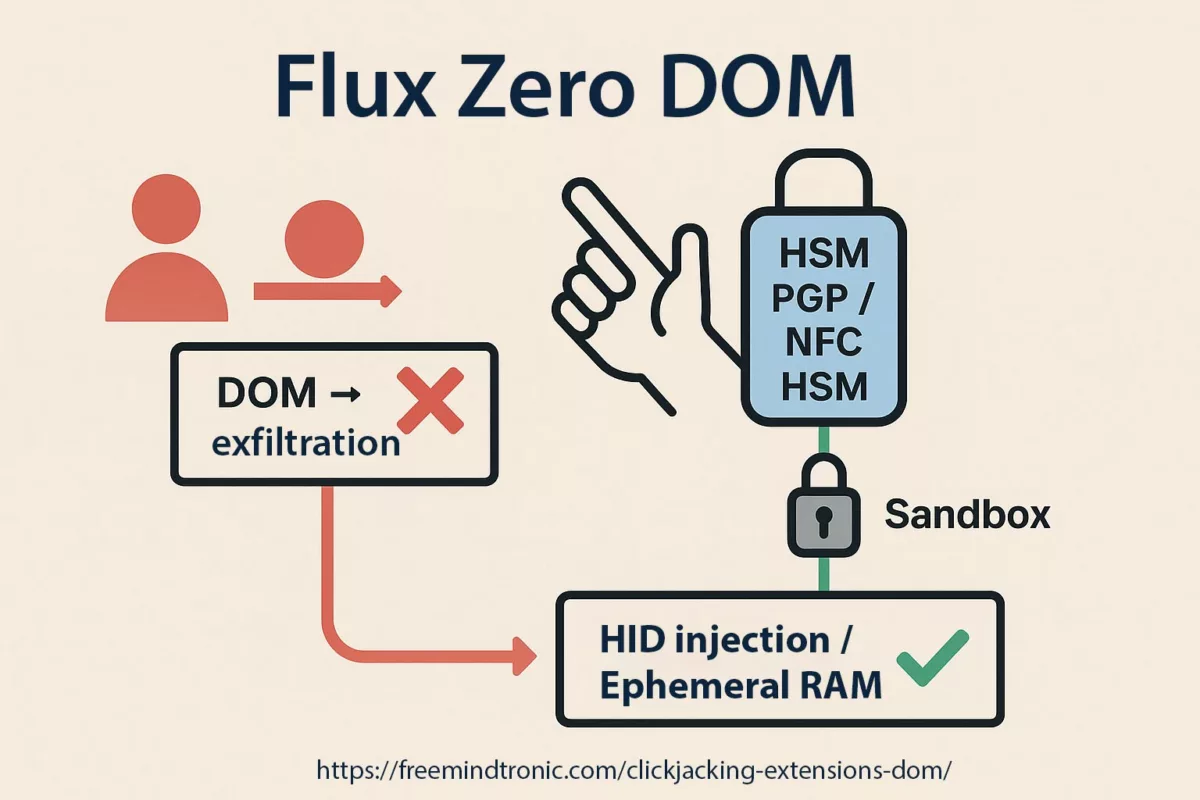
✪ Ilustración — Flujo Zero DOM: los secretos permanecen dentro del HSM, inyectados vía HID en RAM efímera, haciendo imposible la exfiltración DOM.
En este paradigma, los secretos (credenciales, TOTP, passkeys, claves privadas) se preservan en HSMs hardware offline.
El acceso solo es posible mediante activación física (NFC, HID, emparejamiento seguro) y deja una huella efímera en RAM.
Esto elimina por completo la exposición al DOM.
⮞ Operación soberana: NFC HSM, HID BLE y HSM PGP
NFC HSM ↔ Android ↔ Activación en navegador:
Con el NFC HSM, la activación no ocurre con un simple toque.
Requiere presentar físicamente el módulo NFC HSM bajo un smartphone Android con NFC.
La aplicación Freemindtronic recibe la solicitud del ordenador emparejado (vía PassCypher HSM PGP), activa el módulo seguro y transmite el secreto cifrado sin contacto al ordenador.
Todo el proceso es end-to-end cifrado, con descifrado solo en RAM volátil — nunca en el DOM.
NFC HSM ↔ Activación HID BLE:
Emparejado con un emulador de teclado Bluetooth HID (ej. InputStick), la aplicación NFC inyecta credenciales directamente en los campos de login mediante un canal AES-128 CBC cifrado BLE.
De este modo, garantiza autocompletado seguro fuera del DOM, incluso en equipos no emparejados, neutralizando keyloggers y ataques DOM clásicos.
Activación HSM PGP local:
En escritorio, con PassCypher HSM PGP, un solo clic sobre el campo activa el autocompletado instantáneo.
El secreto se descifra localmente desde su contenedor AES-256 CBC PGP, únicamente en RAM volátil, sin NFC y nunca transitando por el DOM.
Esto garantiza una arquitectura soberana de autocompletado, resistente por diseño a extensiones maliciosas y overlays invisibles.
A diferencia de los gestores cloud o passkeys FIDO, estas soluciones no aplican parches reactivos: eliminan la superficie de ataque por diseño.
Es la esencia del enfoque soberano-por-diseño: arquitectura descentralizada, sin servidor central y sin base de datos a filtrar.
⮞ Resumen
Zero DOM no es un parche, sino un cambio doctrinal.
Mientras los secretos vivan en el navegador, seguirán siendo vulnerables.
Al trasladarlos fuera del DOM, cifrados en HSMs y activados físicamente, se vuelven inalcanzables para ataques de clickjacking o BITB.
PassCypher HSM PGP — Tecnología Zero-DOM patentada & gestión soberana de claves anti-phishing
Mucho antes de la revelación del DOM extension clickjacking en DEF CON 33, Freemindtronic tomó una decisión diferente. Desde 2015 nuestro I+D aplica un principio fundacional: nunca usar el DOM para transportar secretos. Esa doctrina Zero-Trust dio lugar a la arquitectura Zero-DOM patentada de PassCypher HSM PGP, que mantiene credenciales, TOTP/HOTP, passkeys y claves criptográficas confinadas en contenedores hardware HSM — nunca inyectadas en un entorno manipulable del navegador.
Un avance único en gestores de contraseñas
- Zero-DOM nativo — ningún dato sensible toca el navegador.
- HSM-PGP integrado — contenedores cifrados AES-256-CBC con segmentación de claves patentada.
- Autonomía soberana — cero servidor, cero base de datos central, cero dependencia cloud.
Protección BITB reforzada (EviBITB)
Desde 2020, PassCypher HSM PGP incorpora EviBITB, una tecnología que neutraliza en tiempo real ataques Browser-in-the-Browser: destruye iframes maliciosos, detecta overlays fraudulentos y valida el contexto UI de forma serverless, sin base de datos y anónima. EviBITB puede funcionar en modo manual, semiautomático o totalmente automático para minimizar el riesgo BITB y el secuestro invisible del DOM.
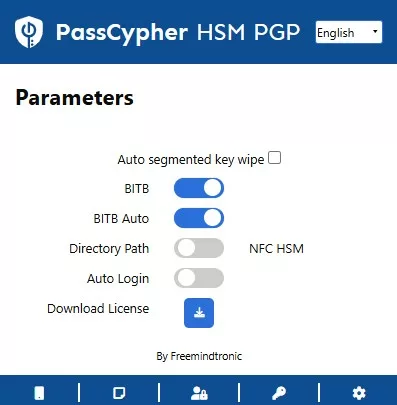
¿Por qué resiste ataques al nivel DEF CON 33?
Porque nada transita por el DOM, no existe contraseña maestra que pueda extraerse, y los contenedores permanecen cifrados en todo momento. El descifrado ocurre únicamente en RAM volátil, durante el instante necesario para ensamblar los segmentos de clave; una vez completado el autocompletado, todo se borra inmediatamente sin dejar rastro explotable.
Características clave
- Autofill blindado — un clic basta, pero siempre vía sandbox de URL; nunca en claro dentro del navegador.
- EviBITB integrado — neutraliza iframes y overlays en tiempo real (manual / semiauto / automático), completamente serverless.
- Herramientas criptográficas integradas — generación y gestión de claves AES-256 segmentadas y claves PGP sin dependencias externas.
- Compatibilidad universal — funciona con cualquier sitio mediante software + extensión de navegador, sin plugins adicionales.
- Arquitectura soberana — cero servidor, cero base central, cero DOM: resiliencia por diseño donde los gestores cloud fallan.
Implementación inmediata
Sin configuración compleja: instala la extensión PassCypher HSM PGP desde la Chrome Web Store o Edge Add-ons, activa la opción BITB y obtén protección Zero-DOM soberana al instante.
⮞ Resumen
PassCypher HSM PGP redefine la gestión de secretos: contenedores siempre cifrados, claves segmentadas, descifrado efímero en RAM, Zero-DOM y cero cloud. Es una solución hardware passwordless soberana diseñada para resistir las amenazas actuales y anticipar ataques cuánticos.
PassCypher NFC HSM — Gestor Soberano sin Contraseñas
Los gestores de contraseñas basados en software caen en la trampa de un simple iframe.
Sin embargo, PassCypher NFC HSM sigue un camino diferente: nunca permite que tus credenciales y contraseñas transiten por el DOM.
El nano-HSM las mantiene cifradas offline y solo las libera por un instante efímero en memoria volátil — lo justo para autenticar.
Funcionamiento en el lado del usuario:
- Secretos intocables — el NFC HSM cifra y almacena credenciales que nunca aparecen ni se filtran.
- TOTP/HOTP — la app Android PassCypher NFC HSM o el PassCypher HSM PGP en escritorio los generan y muestran al instante bajo demanda.
- Entrada manual — el usuario introduce un PIN o TOTP directamente en el campo de login en un ordenador o teléfono NFC Android. La app muestra el código generado por el módulo NFC HSM. El mismo proceso aplica a credenciales, passkeys y otros secretos.
- Autocompletado sin contacto — el usuario presenta el módulo NFC HSM a un smartphone o PC, que ejecuta el autofill de forma transparente, incluso emparejado con PassCypher HSM PGP.
- Autofill en escritorio — con PassCypher HSM PGP en Windows o macOS, un clic sobre el campo de login completa usuario y contraseña, con validación opcional.
- Anti-BITB distribuido — el emparejamiento seguro NFC ↔ Android ↔ navegador (Win/Mac/Linux) activa EviBITB para destruir iframes maliciosos en tiempo real.
- Modo HID BLE — un emulador de teclado Bluetooth HID inyecta credenciales fuera del DOM, bloqueando tanto ataques DOM como keyloggers.
⮞ Resumen
PassCypher NFC HSM materializa Zero Trust (cada acción requiere validación física) y Zero Knowledge (ningún secreto se expone jamás).
Un salvaguarda soberano de identidad por diseño, que neutraliza clickjacking, ataques BITB, typosquatting, keylogging, IDN spoofing, inyecciones DOM, clipboard hijacking y extensiones maliciosas, anticipando incluso ataques cuánticos.
✪ Ataques Neutralizados por PassCypher NFC HSM
| Tipo de ataque | Descripción | Estado con PassCypher |
|---|---|---|
| Clickjacking / UI Redressing | Iframes u overlays invisibles que secuestran clics | Neutralizado (EviBITB) |
| BITB (Browser-in-the-Browser) | Marcos falsos de navegador simulando login | Neutralizado (sandbox + emparejamiento) |
| Keylogging | Captura de pulsaciones por malware | Neutralizado (modo HID BLE) |
| Typosquatting | URLs parecidas que imitan dominios legítimos | Neutralizado (validación física) |
| Ataque Homográfico (IDN spoofing) | Sustitución Unicode en nombres de dominio | Neutralizado (Zero DOM) |
| Inyección DOM / DOM XSS | Scripts maliciosos en el DOM | Neutralizado (arquitectura fuera del DOM) |
| Clipboard Hijacking | Intercepción o manipulación de datos del portapapeles | Neutralizado (sin uso del portapapeles) |
| Extensiones maliciosas | Plugins de navegador comprometidos | Neutralizado (emparejamiento + sandbox) |
| Ataques Cuánticos (anticipados) | Cálculo masivo para romper claves criptográficas | Mitigado (claves segmentadas + AES-256 CBC + PGP) |
SeedNFC + HID Bluetooth — Inyección Segura de Wallets
Las extensiones de navegador para billeteras cripto viven en el DOM — y los atacantes explotan esa debilidad.
Con SeedNFC HSM, la lógica se invierte: el enclave nunca libera claves privadas ni frases semilla.
Cuando los usuarios inicializan o restauran una wallet (web o escritorio), el sistema realiza la entrada mediante una emulación HID Bluetooth — como un teclado hardware — sin portapapeles, sin DOM y sin dejar rastros de claves privadas, públicas o credenciales de hot wallets.
Flujo operativo (anti-DOM, anti-portapapeles):
- Custodia — el SeedNFC HSM cifra y almacena la semilla/clave privada (nunca la exporta, nunca la revela).
- Activación física — el módulo NFC HSM autoriza la operación cuando el usuario lo presenta de forma contactless a través de la app Freemindtronic (smartphone Android NFC).
- Inyección HID BLE — el sistema “teclea” la semilla (o fragmento/format requerido) directamente en el campo de la wallet, fuera del DOM y fuera del portapapeles, resistiendo incluso keyloggers de software.
- Protección BITB — los usuarios pueden activar EviBITB (motor anti-BITB destruye iframes) dentro de la app, neutralizando overlays y redirecciones maliciosas en la configuración o recuperación.
- Efimeridad — la RAM volátil mantiene temporalmente los datos durante la entrada HID, para borrarlos al instante.
Casos de uso típicos:
- Onboarding o recuperación de wallets (MetaMask, Phantom, etc.) sin exponer nunca la clave privada al navegador ni al DOM. El HSM mantiene el secreto cifrado y lo descifra solo en RAM, el tiempo mínimo necesario.
- Operaciones sensibles en escritorio (air-gap lógico), con validación física por el usuario: presentar el módulo NFC HSM bajo un smartphone NFC Android para autorizar, sin teclado ni DOM.
- Backup seguro multi-activo: un HSM hardware offline almacena frases semilla, claves maestras y privadas, permitiendo reutilización sin copiar, exportar ni exponer. La activación siempre ocurre por medios físicos, soberanos y auditables.
⮞ Resumen
En primer lugar, SeedNFC HSM con HID BLE inyecta claves privadas o públicas directamente en los campos de hot wallets mediante un emulador HID Bluetooth Low Energy, evitando tanto la escritura manual como la transferencia por portapapeles.
Además, el canal cifra los datos con AES-128 CBC, mientras el módulo NFC activa físicamente la operación, garantizando un proceso seguro y verificable.
Por último, el enclave HSM mantiene los secretos estrictamente confinados, fuera del DOM y más allá del alcance de extensiones maliciosas, asegurando así protección soberana por diseño.
Escenarios de Explotación y Rutas de Mitigación
Las revelaciones de DEF CON 33 no son el final del juego, sino una advertencia.
Lo que sigue puede resultar aún más corrosivo:
- Phishing impulsado por IA + secuestro del DOM — mañana ya no serán kits de phishing caseros, sino LLMs generando superposiciones DOM en tiempo real, virtualmente indistinguibles de portales legítimos de banca o nube.
Estos ataques de clickjacking potenciados por IA convertirán el robo de credenciales vía Shadow DOM en un arma a escala. - Tapjacking móvil híbrido — la pantalla táctil se convierte en un campo minado: aplicaciones apiladas, permisos invisibles y gestos en segundo plano secuestrados para validar transacciones o exfiltrar OTPs.
Esto representa la evolución del tapjacking de phishing hacia un compromiso sistémico en entornos móviles. - HSM preparado para la era post-cuántica — la próxima línea de defensa no será un parche del navegador, sino HSMs resistentes a la computación cuántica, capaces de soportar los algoritmos de Shor o Grover.
Soluciones como PassCypher HSM PGP y SeedNFC, ya concebidas como anclajes soberanos Zero-DOM post-cloud, encarnan este cambio de paradigma.
⮞ Resumen
Los atacantes del futuro no confiarán en parches del navegador: los sortearán.
Para mitigar la amenaza, se impone una ruptura: soportes hardware offline, HSMs resistentes a la cuántica y arquitecturas soberanas Zero-DOM.
Rechaza todas las demás opciones: siguen siendo parches frágiles de software que inevitablemente se quebrarán.
Síntesis Estratégica
El clickjacking extensiones DOM revela una verdad contundente: los navegadores y las extensiones no son entornos de confianza.
Los parches llegan en oleadas fragmentadas, la exposición de usuarios alcanza decenas de millones y los marcos regulatorios permanecen en un eterno desfase.
¿El único camino soberano? Una estricta gobernanza del software, combinada con salvaguardas hardware offline fuera del DOM (PassCypher NFC HSM / PassCypher HSM PGP), donde los secretos permanecen cifrados, offline e intocables por técnicas de redressing.
La Vía Soberana:
- Gobernanza estricta de software y extensiones
- Seguridad de identidad respaldada en hardware (PassCypher NFC HSM / HSM PGP)
- Secretos cifrados, fuera del DOM, fuera de la nube, redress-proof
Doctrina de Soberanía Cibernética en Hardware —
- Considerar cualquier secreto que toque el DOM como ya comprometido.
- Activar la identidad digital únicamente mediante acciones físicas (NFC, HID BLE, HSM PGP).
- Fundar la confianza en el aislamiento hardware, no en el sandbox del navegador.
- Auditar extensiones como si fueran infraestructuras críticas.
- Garantizar resiliencia post-cuántica aislando físicamente las claves.
CRA, NIS2 o RGS (ANSSI) refuerzan la resiliencia del software, pero ninguno aborda los secretos incrustados en el DOM.
La custodia en hardware sigue siendo el único recurso soberano — y solo los estados capaces de producir y certificar sus propios HSMs pueden garantizar una verdadera soberanía digital.
El clickjacking en DOM se suma a una secuencia oscura: ToolShell, secuestro de eSIM, Atomic Stealer… cada uno exponiendo los límites estructurales de la confianza en software.
La doctrina de una ciberseguridad soberana anclada en hardware ya no es opcional. Se ha convertido en una línea base estratégica fundamental.
Glosario
-
DOM (Document Object Model)
- Representación en memoria de la estructura HTML/JS de una página web; permite a scripts y extensiones acceder y modificar elementos de la página.
-
Shadow DOM
- Subárbol DOM encapsulado usado para aislar componentes (web components); puede ocultar elementos al resto del documento.
-
Clickjacking (secuestro de clics)
- Técnica de «UI redressing» que engaña al usuario para que haga clic en elementos ocultos o superpuestos.
-
DOM-Based Extension Clickjacking
- Variante donde una página maliciosa combina iframes invisibles, Shadow DOM y redirecciones (
focus()) para forzar a una extensión a inyectar secretos en un formulario falso. -
Autofill / Autorrelleno
- Mecanismo de gestores/extensiones que inserta automáticamente credenciales, códigos OTP o passkeys en campos web.
-
Passkey
- Credencial de autenticación WebAuthn (basada en clave pública). Las passkeys almacenadas en el dispositivo son más resistentes al phishing; las sincronizadas en la nube son más vulnerables.
-
WebAuthn / FIDO
- Estándar de autenticación con clave pública (FIDO2) para inicios de sesión sin contraseña; la seguridad depende del modelo de almacenamiento (sincronizado vs device-bound).
-
TOTP / HOTP
- Códigos de un solo uso generados por algoritmo temporal (TOTP) o por contador (HOTP) para autenticación de dos factores.
-
HSM (Hardware Security Module)
- Módulo hardware seguro para generar, almacenar y usar claves criptográficas sin exponerlas en claro fuera de la enclave.
-
PGP (Pretty Good Privacy)
- Estándar de cifrado híbrido con claves públicas/privadas; aquí usado para proteger contenedores cifrados AES-256-CBC.
-
AES-256 CBC
- Algoritmo de cifrado simétrico (modo CBC) con clave de 256 bits — usado para cifrar contenedores de secretos.
-
Claves segmentadas
- Fragmentación de claves en segmentos para aumentar la resistencia y permitir el ensamblaje seguro en RAM efímera.
-
RAM efímera
- Memoria volátil donde los secretos se descifran brevemente para autofill y se borran inmediatamente — sin persistencia en disco ni en el DOM.
-
NFC (Near Field Communication)
- Tecnología sin contacto para activar físicamente un HSM y autorizar la liberación local de un secreto.
-
HID-BLE (Bluetooth Low Energy HID)
- Emulación de teclado por BLE para inyectar datos directamente en un campo sin pasar por el DOM ni el portapapeles.
-
Sandbox URL
- Mecanismo que vincula cada secreto a una URL esperada almacenada en el HSM; si la URL activa no coincide, el autofill se bloquea.
-
Browser-in-the-Browser (BITB)
- Ataque por imitación de una ventana de navegador dentro de un iframe — engaña al usuario simulando un sitio o cuadro de autenticación.
-
EviBITB
- Motor anti-BITB serverless que detecta y destruye iframes/overlays maliciosos en tiempo real y valida el contexto UI de forma anónima.
-
SeedNFC
- Solución HSM para custodia de seed phrases/ claves privadas; realiza la inyección fuera del DOM vía HID/NFC.
-
Iframe
- Marco HTML que incorpora otra página; los iframes invisibles (opacity:0, pointer-events:none) son comunes en ataques de UI redressing.
focus()- Llamada JavaScript que sitúa el foco en un campo. Abusada para redirigir eventos de usuario a inputs controlados por el atacante.
-
Overlay
- Capa visual que oculta la interfaz real y puede engañar al usuario sobre el origen de una acción.
-
Exfiltración
- Extracción no autorizada de datos sensibles del objetivo (credenciales, TOTP, passkeys, claves privadas).
-
Phishable
- Describe un mecanismo (p. ej. passkeys sincronizadas) susceptible de ser comprometido por falsificación de interfaz o overlays — por tanto vulnerable al phishing.
-
Content-Security-Policy (CSP)
- Política web que controla orígenes de recursos; útil pero insuficiente por sí sola frente a variantes avanzadas de clickjacking.
-
X-Frame-Options / frame-ancestors
- Cabeceras HTTP / directivas CSP destinadas a limitar la inclusión en iframes; pueden ser eludidas en escenarios de ataque complejos.
-
Keylogging
- Captura maliciosa de pulsaciones de teclado; mitigada por inyecciones HID seguras (sin teclado software ni portapapeles).
Nota: este glosario unifica el vocabulario técnico de la crónica. Para definiciones normativas y referencias, consulte OWASP, NIST y los estándares FIDO/WebAuthn.
⮞ Nota — Lo que esta crónica no cubre:
Ante todo, este análisis no proporciona ni una prueba de concepto explotable ni un tutorial técnico para reproducir ataques de clickjacking extensiones DOM o phishing de passkeys.
Además, no aborda los aspectos económicos de las criptomonedas ni las implicaciones legales específicas fuera de la UE.
En cambio, el objetivo es claro: ofrecer una lectura soberana y estratégica.
Es decir, ayudar a los lectores a comprender fallos estructurales, identificar riesgos sistémicos y, sobre todo, resaltar las contramedidas Zero-DOM hardware (PassCypher, SeedNFC) como vía hacia una seguridad resiliente y resistente al phishing.
En última instancia, esta perspectiva invita a decisores y expertos en seguridad a mirar más allá de los parches temporales de software y adoptar arquitecturas soberanas basadas en hardware.



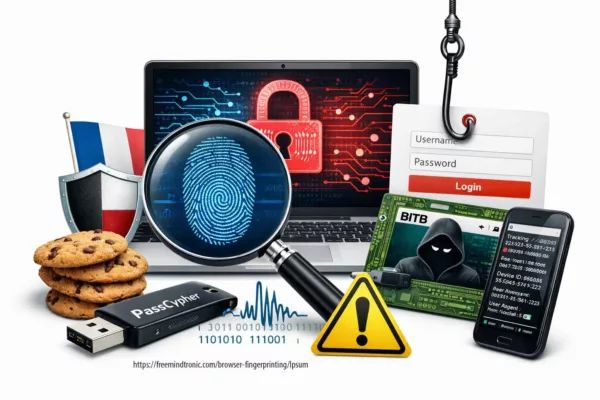





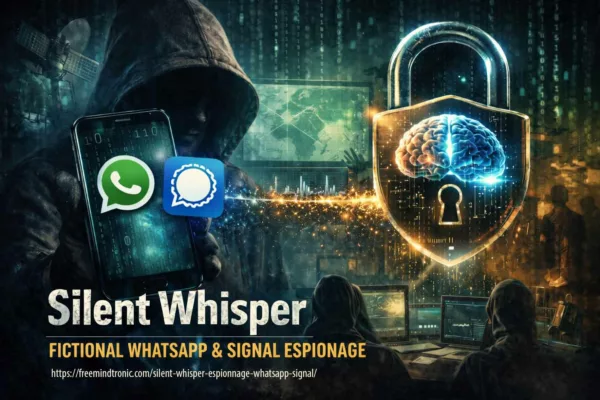

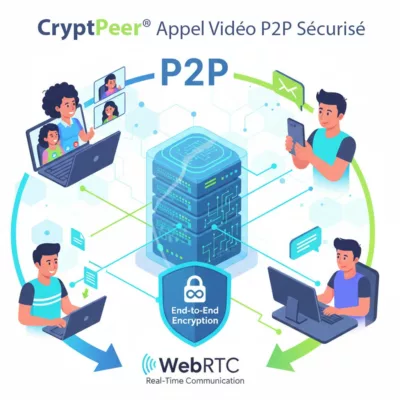
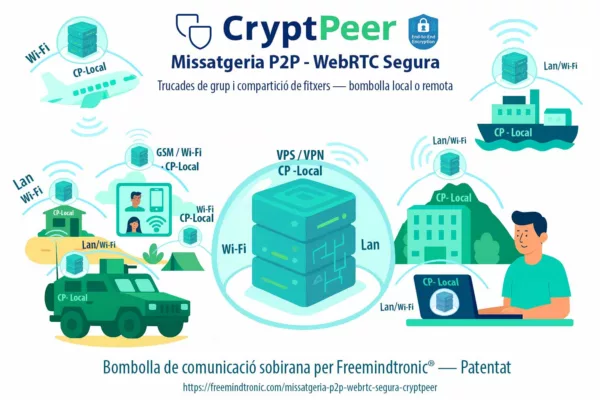


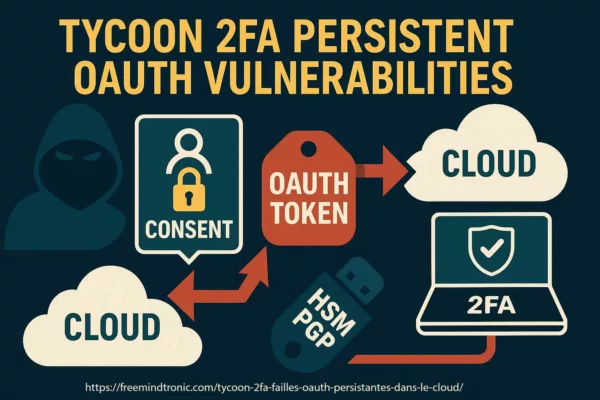

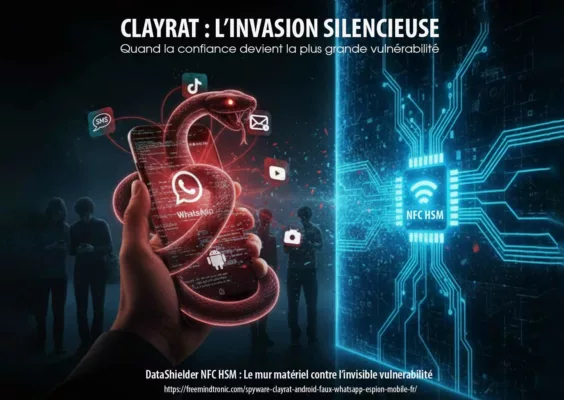

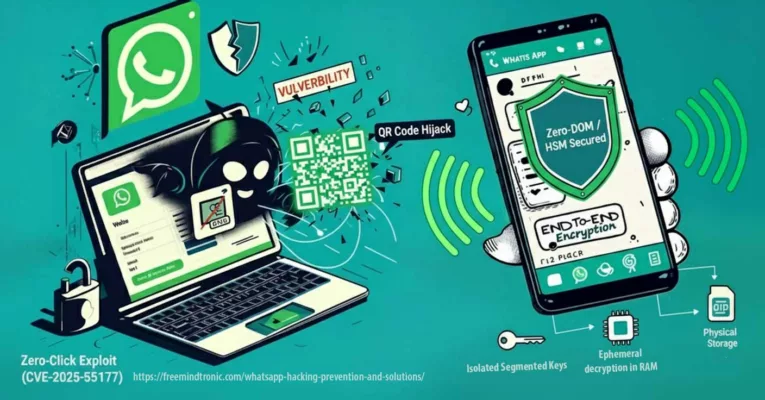

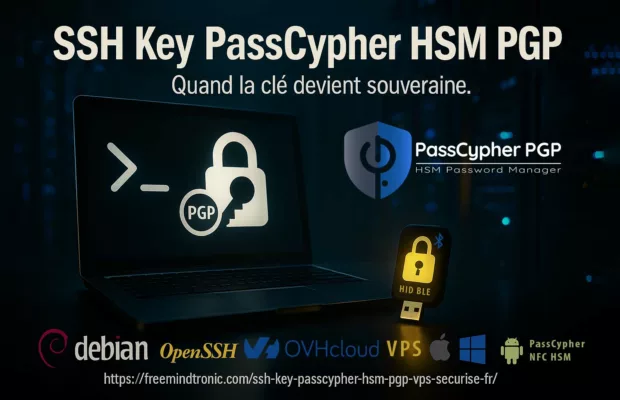
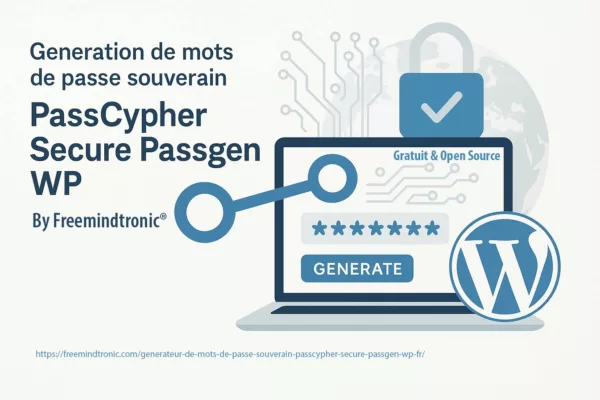
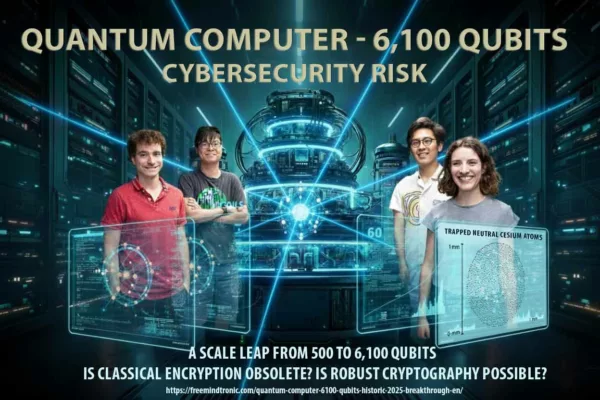
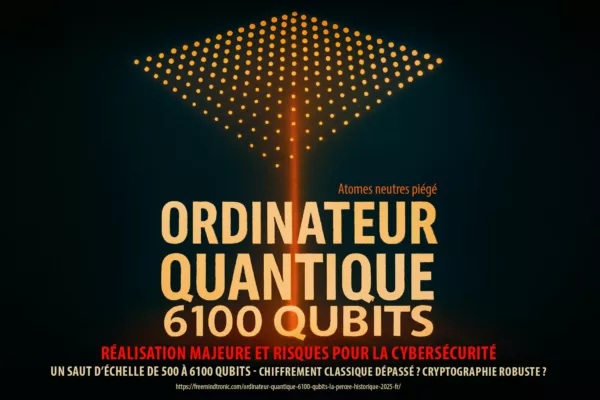
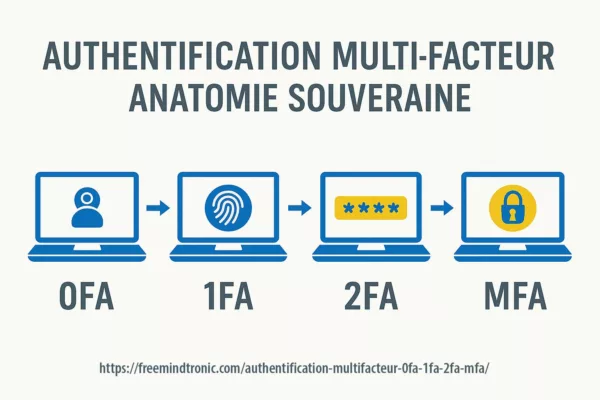

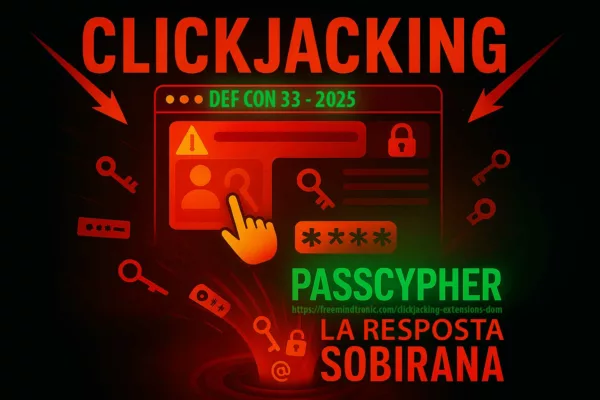
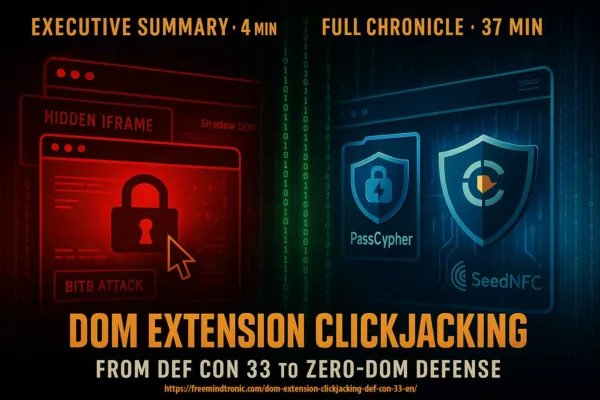
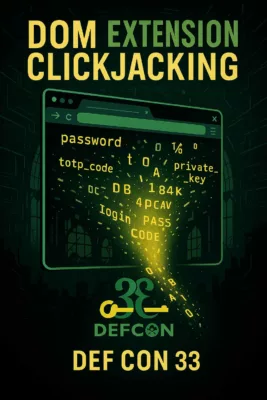
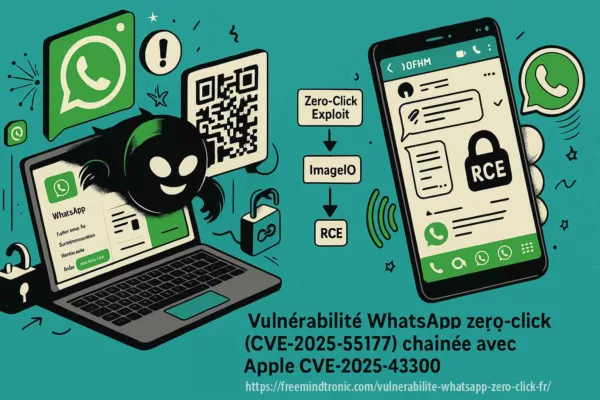

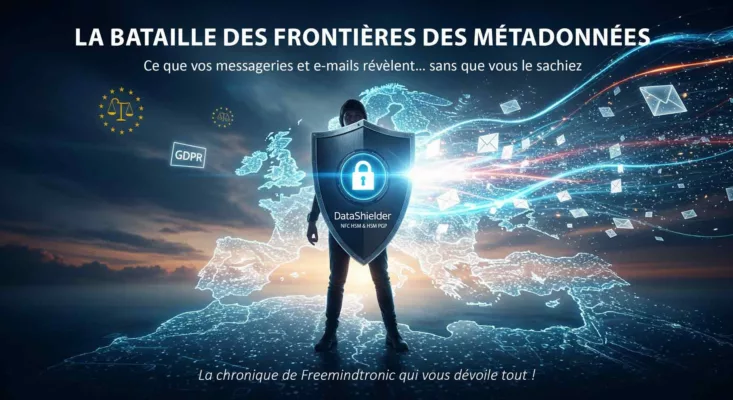
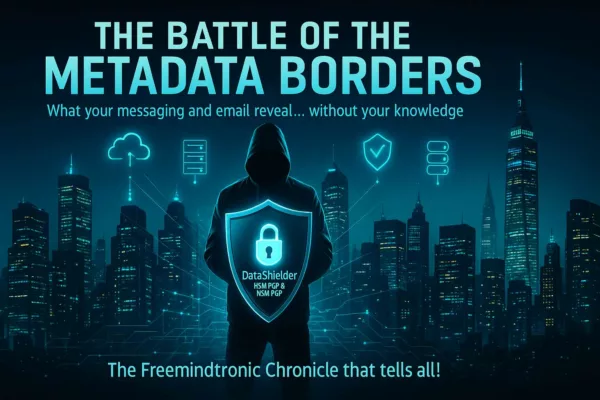






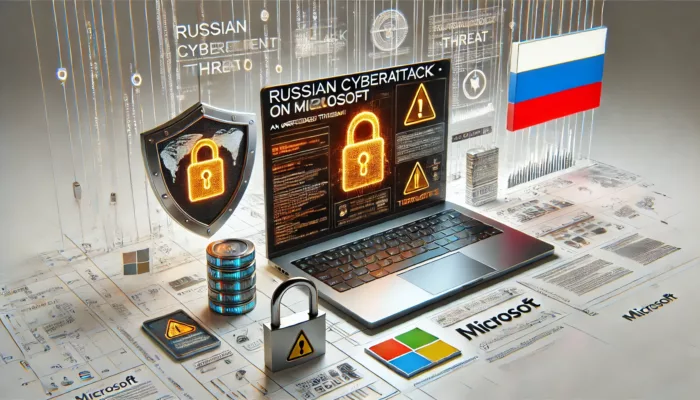

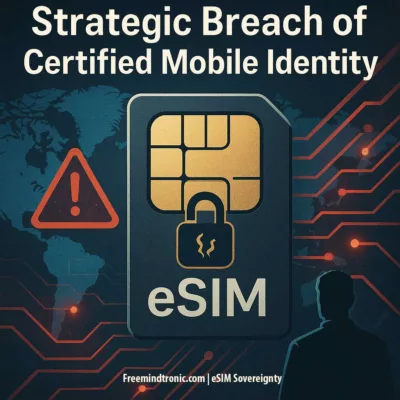

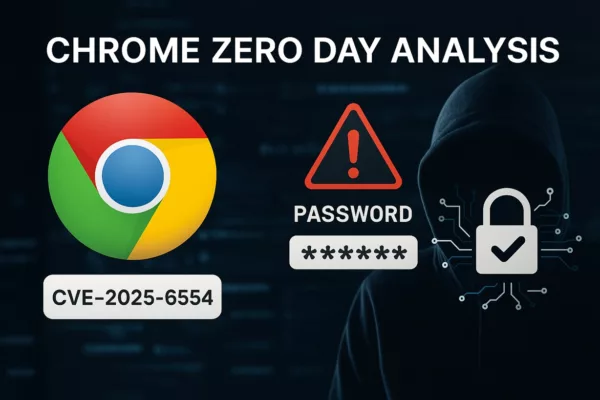
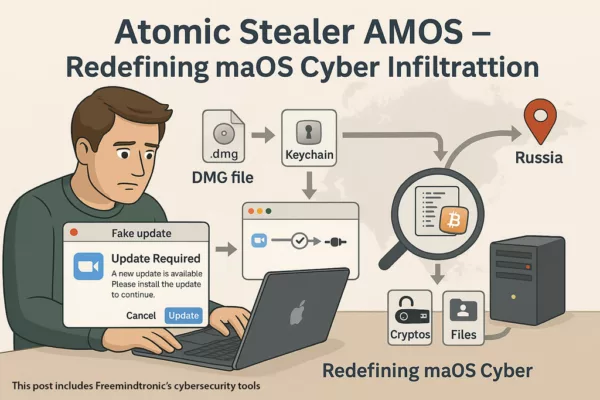

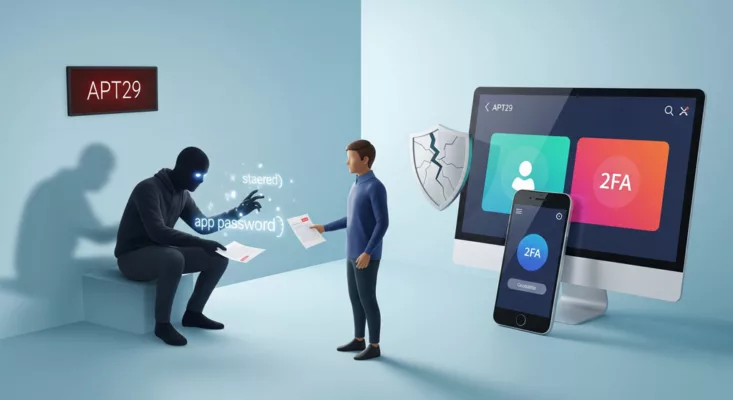

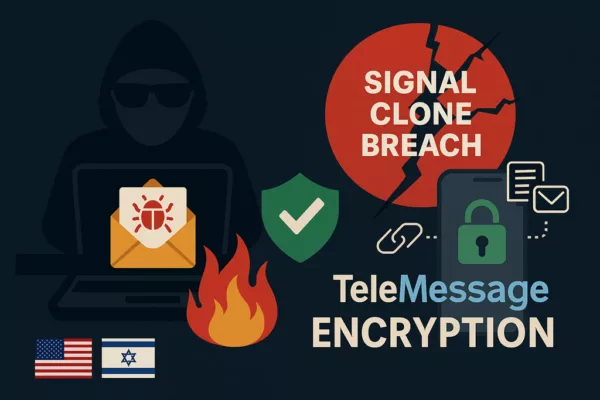
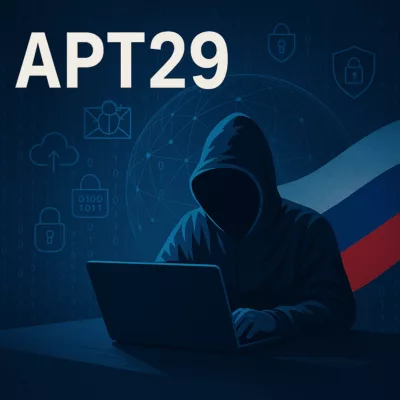
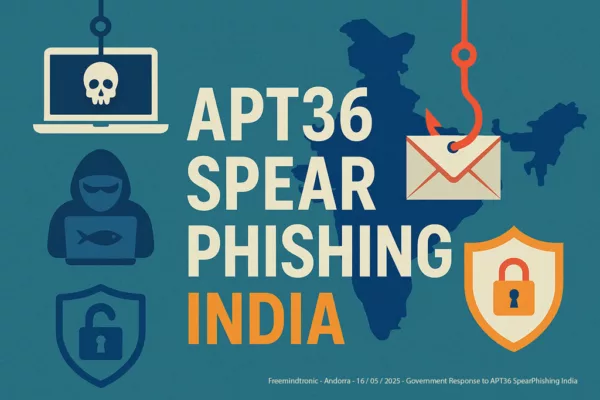
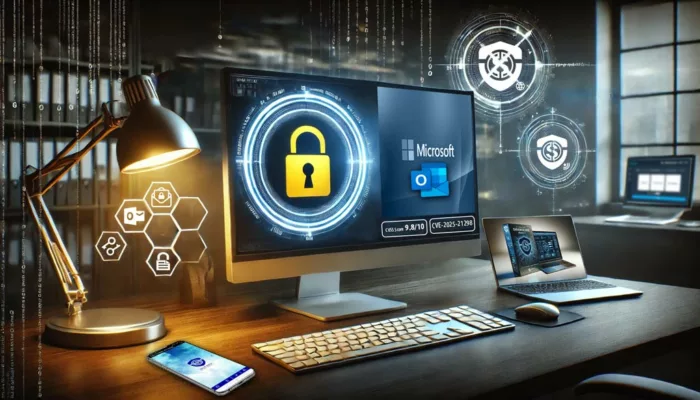






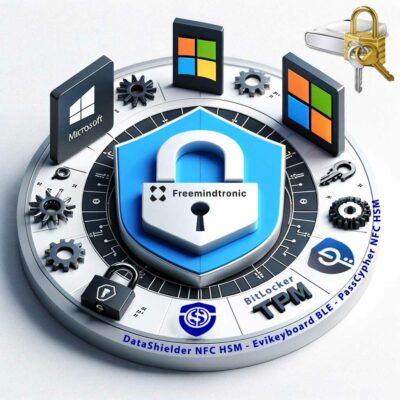






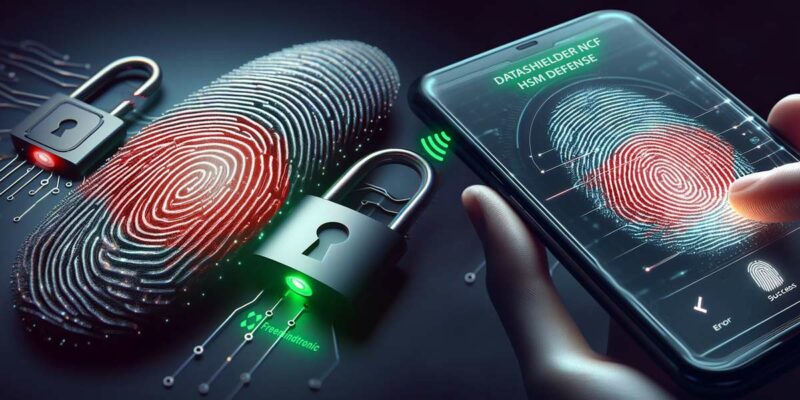
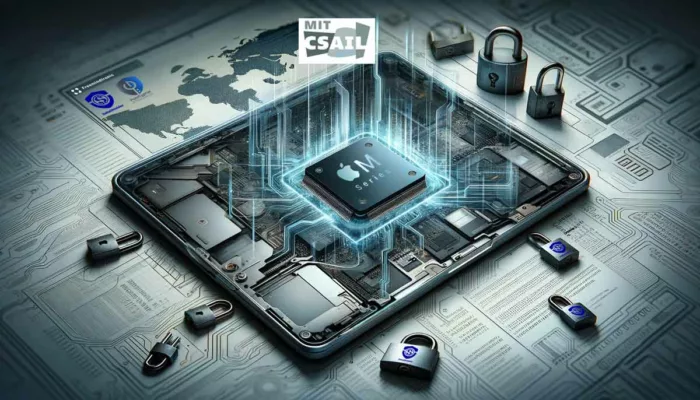

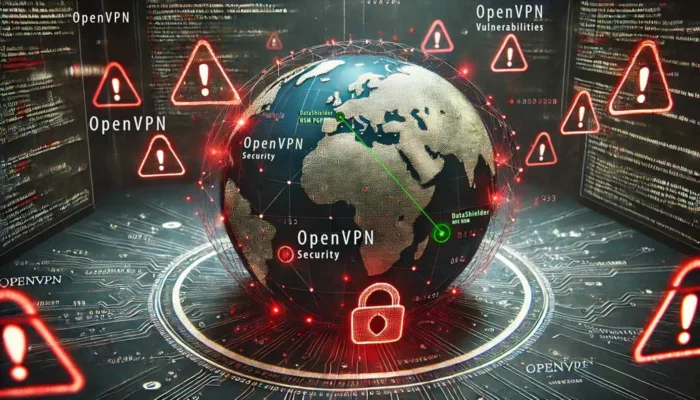


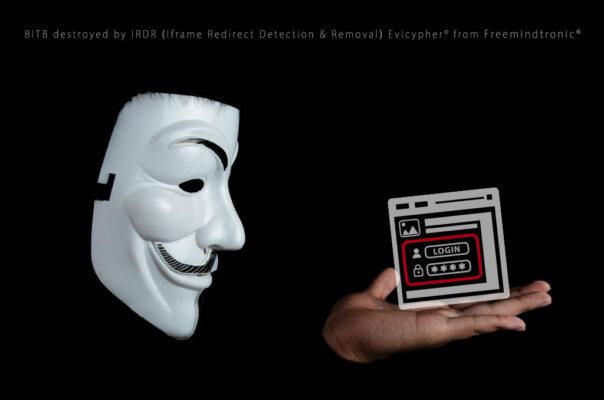


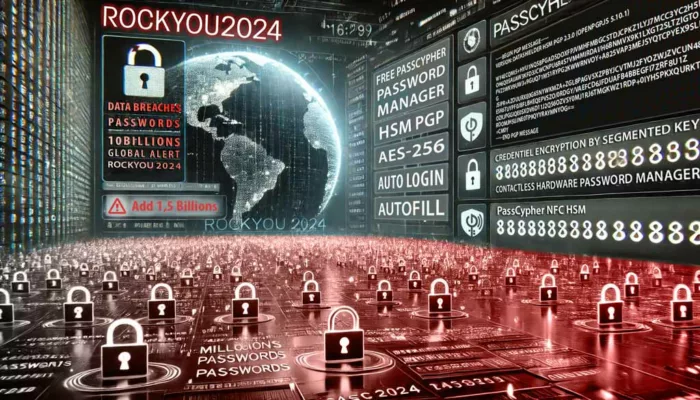


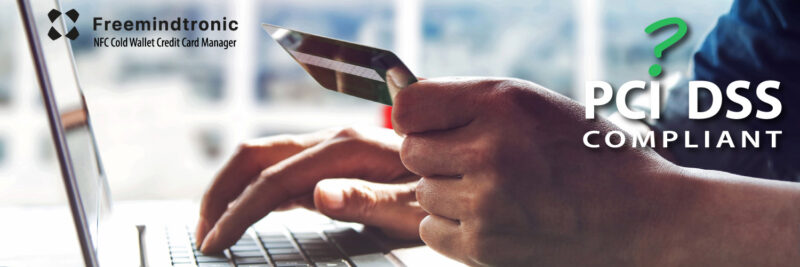


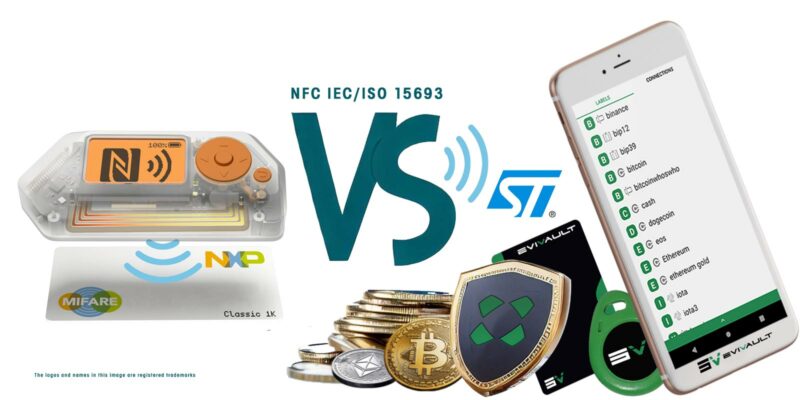





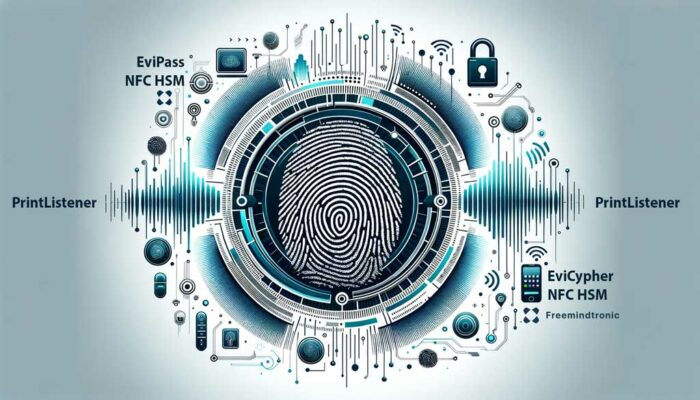
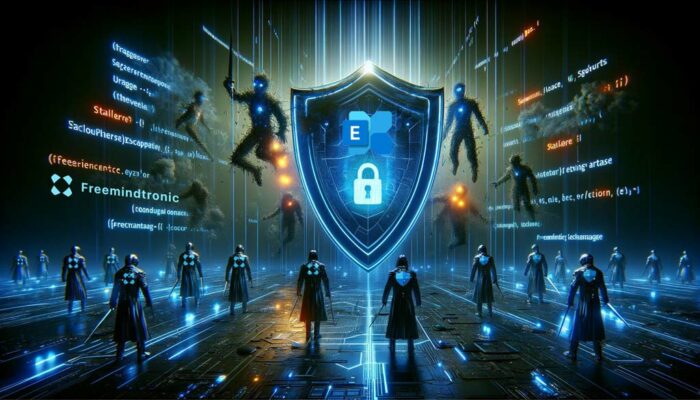







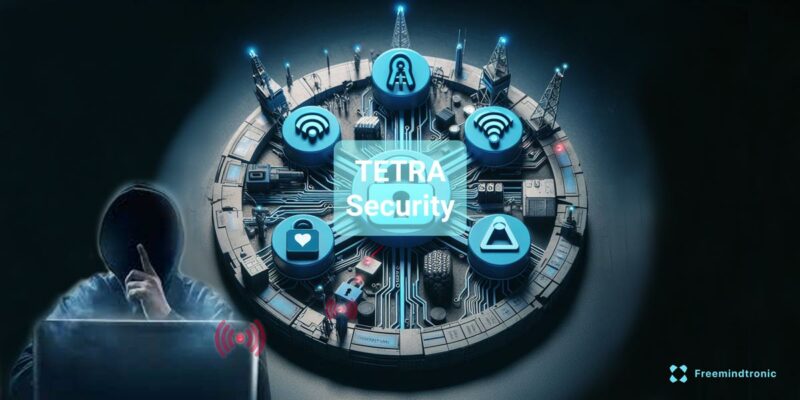







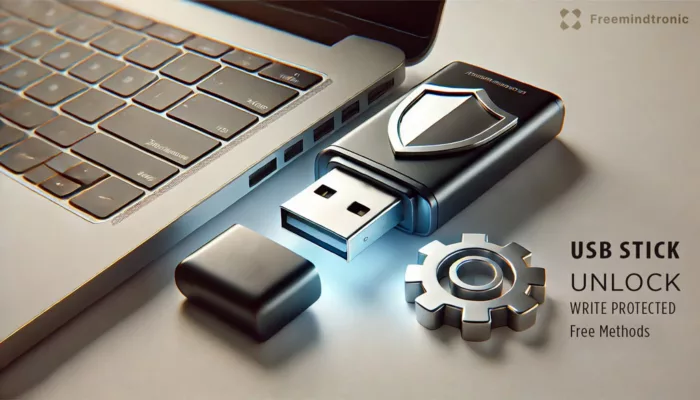
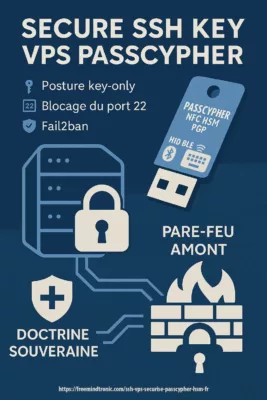
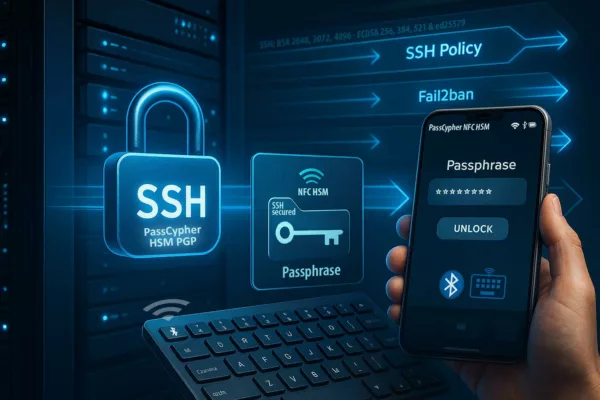


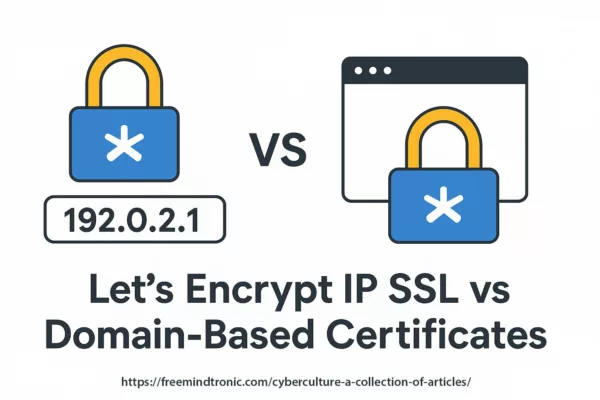
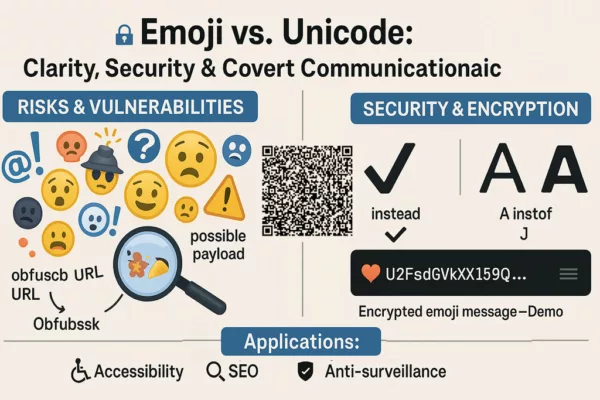
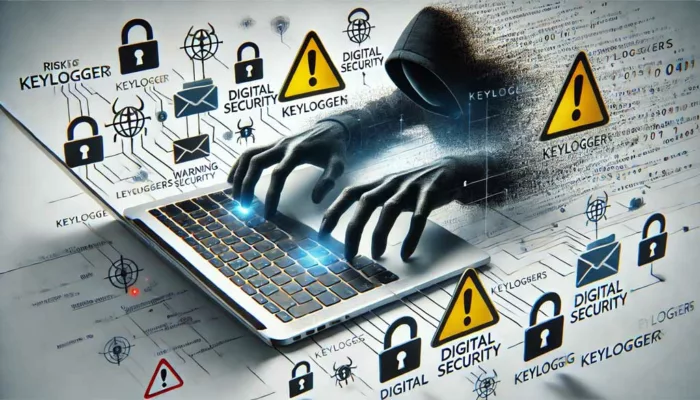
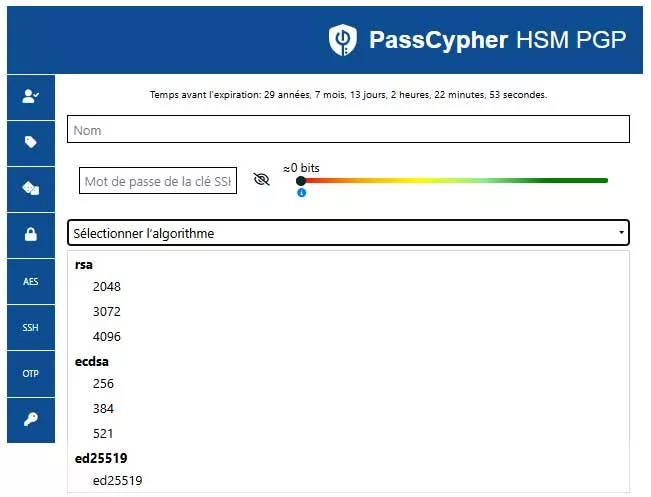
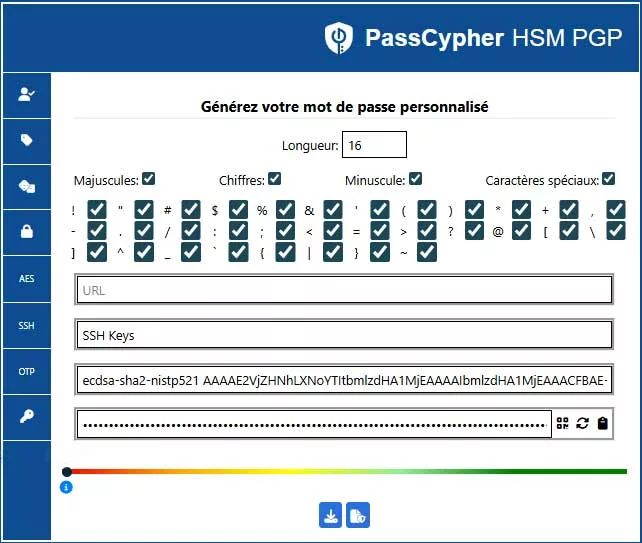

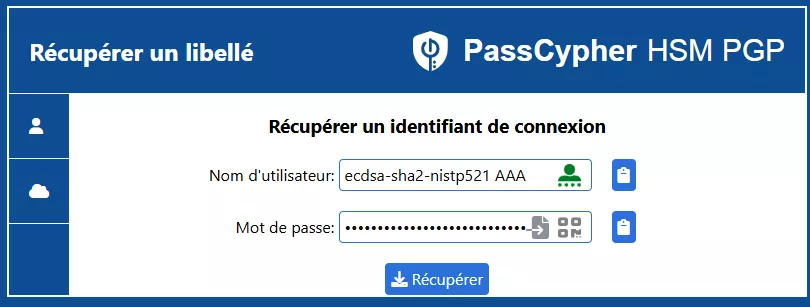


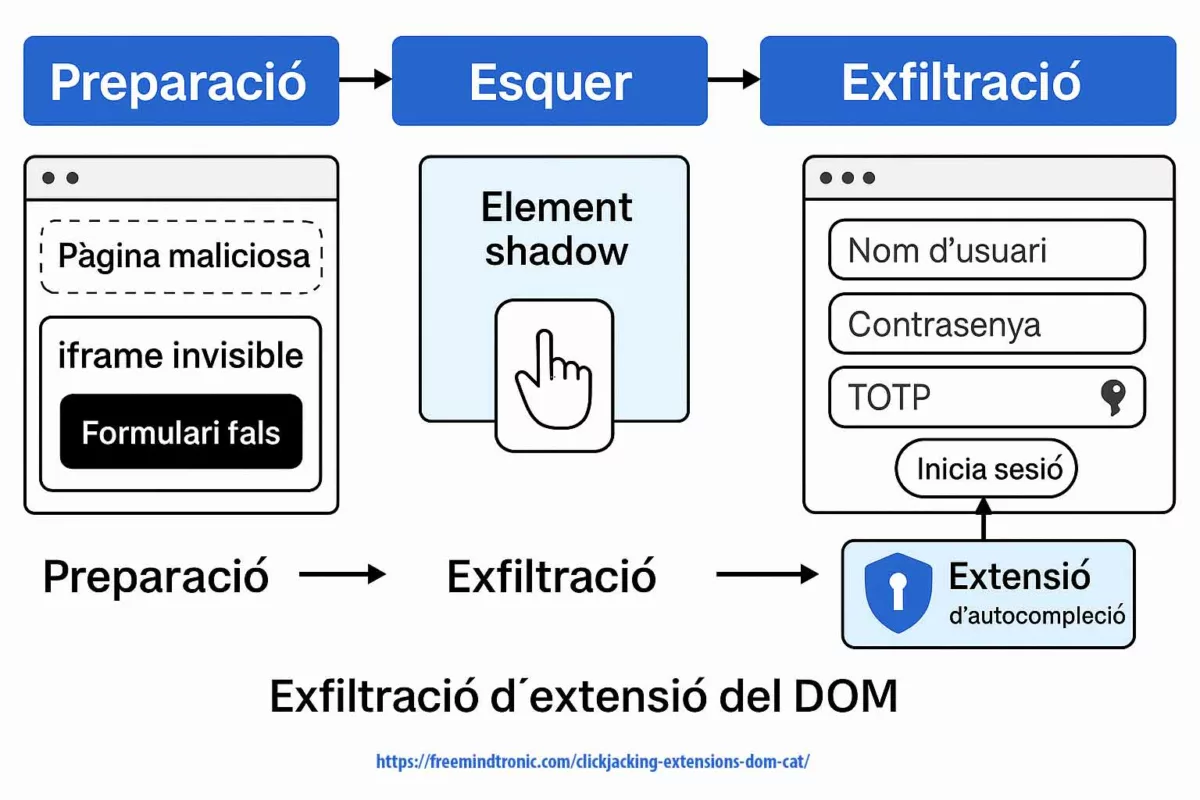
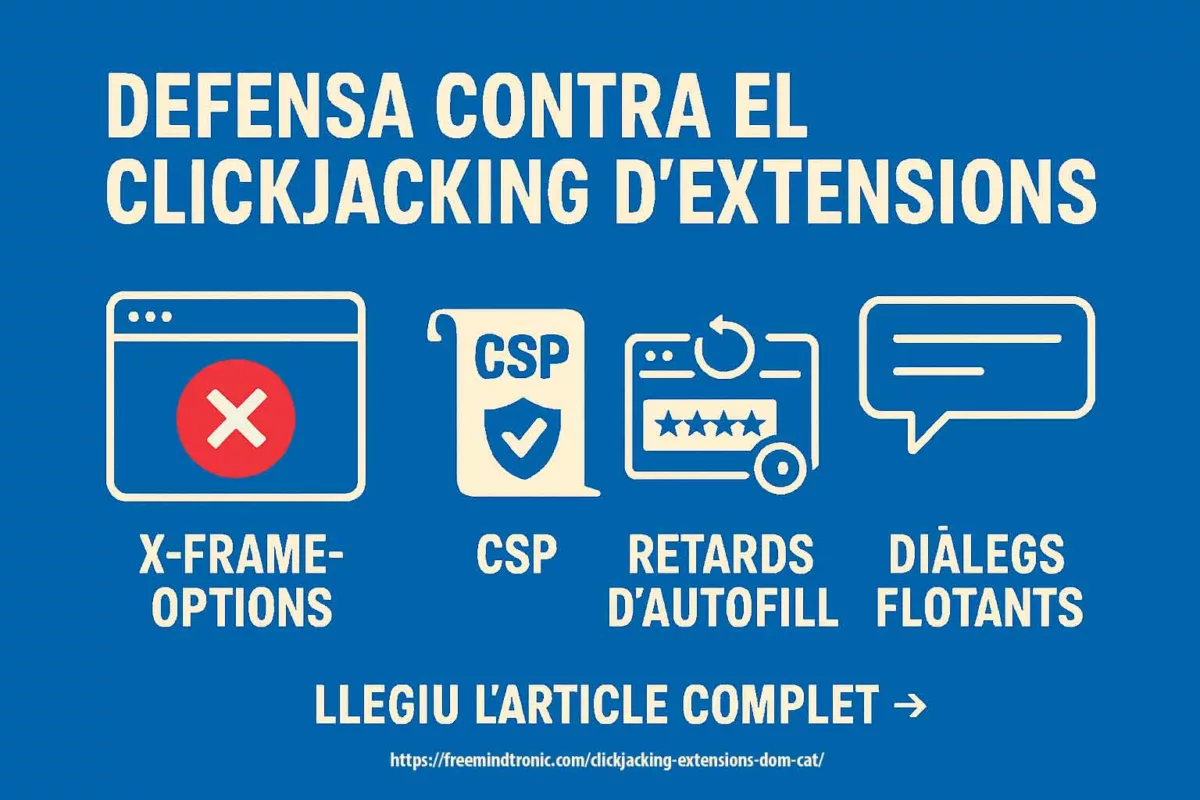
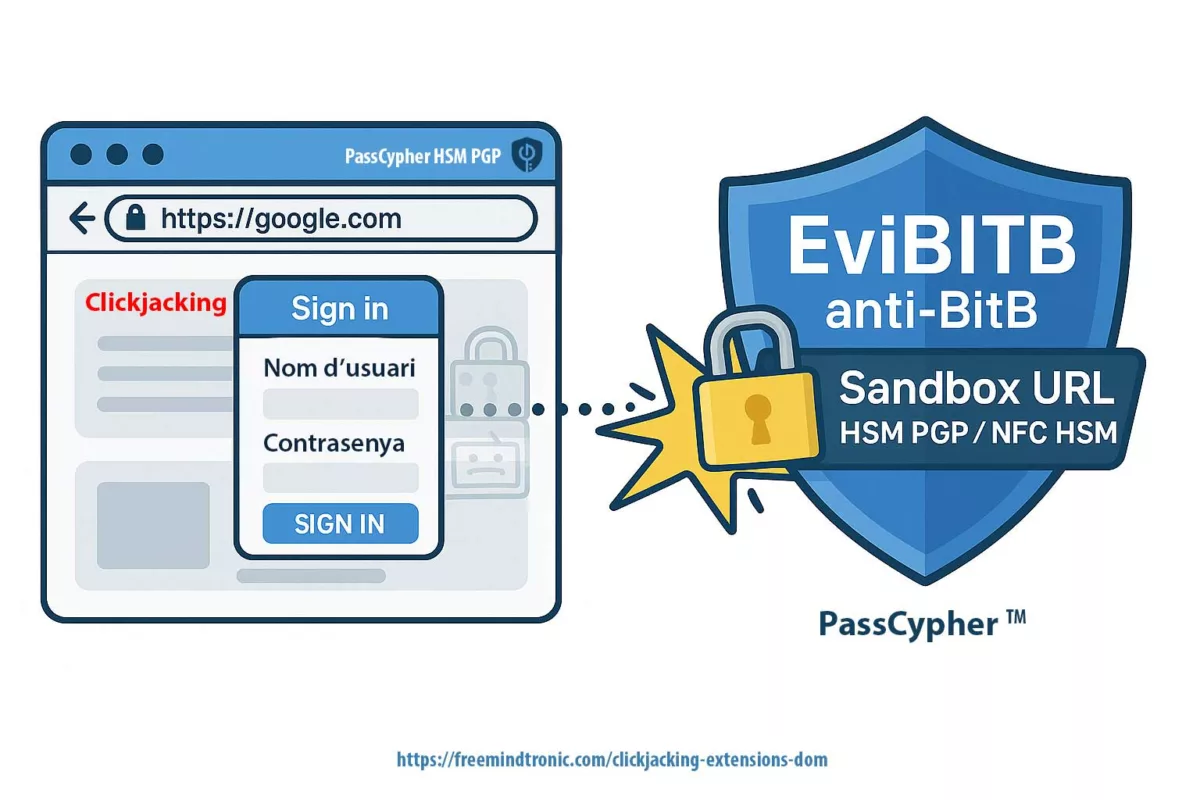
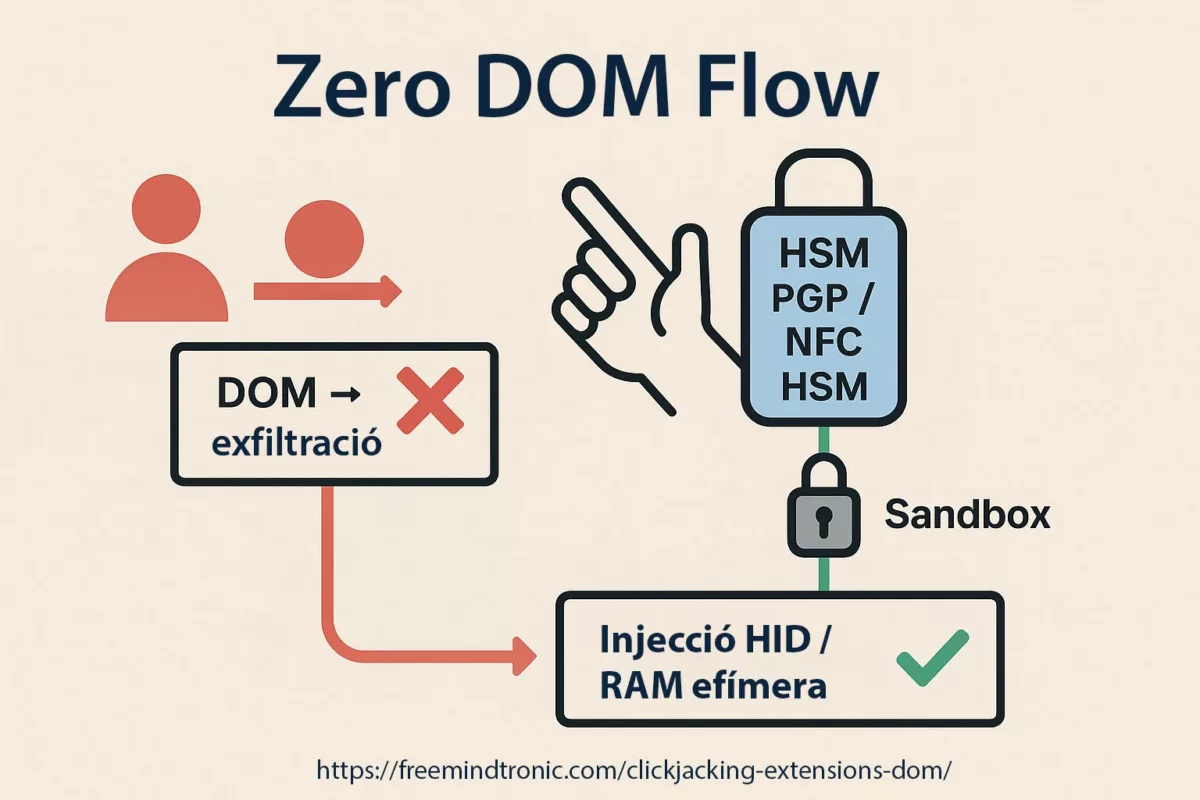



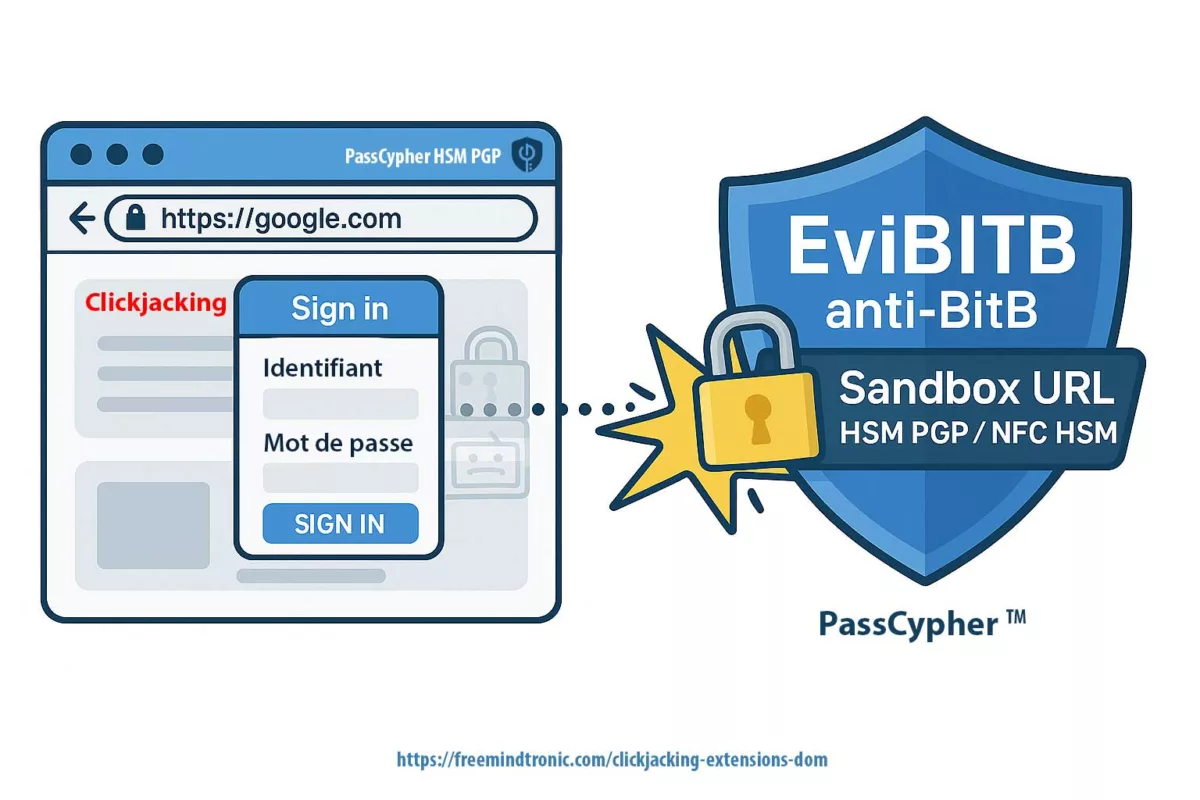

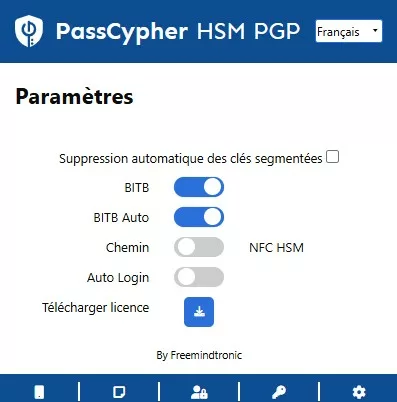



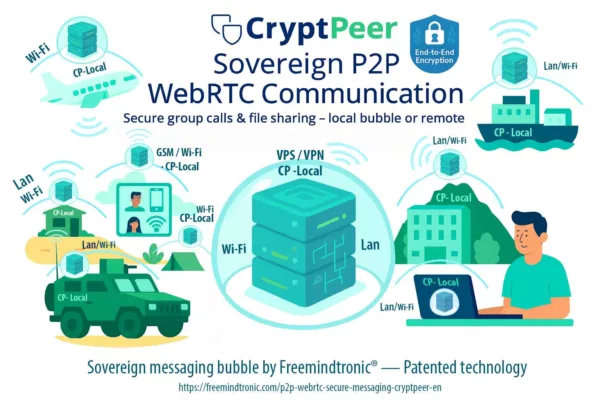




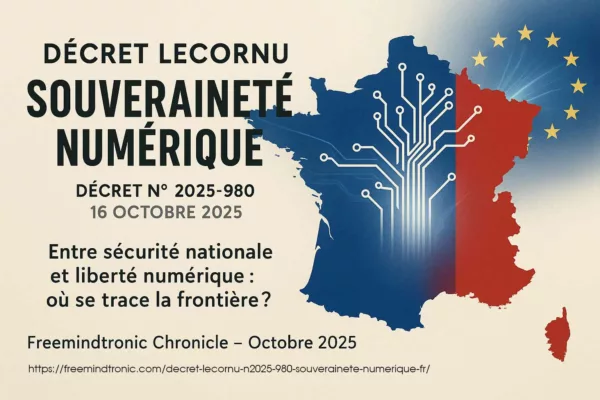




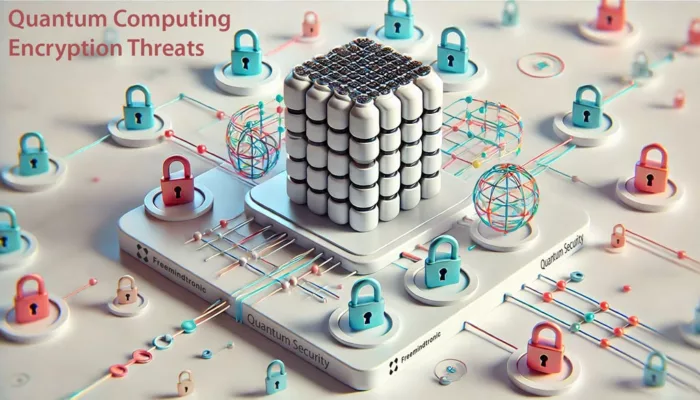

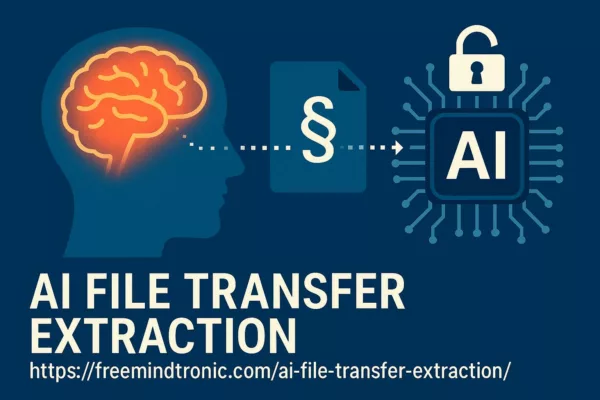
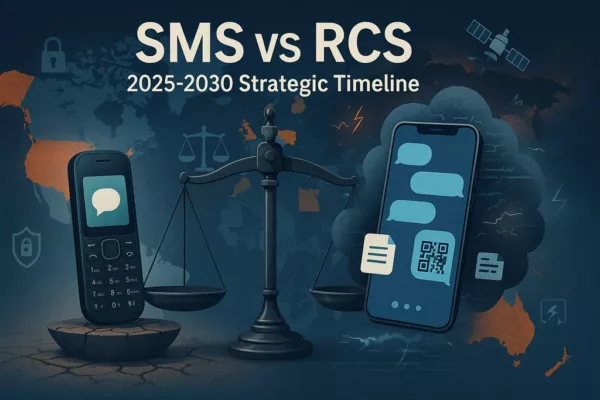
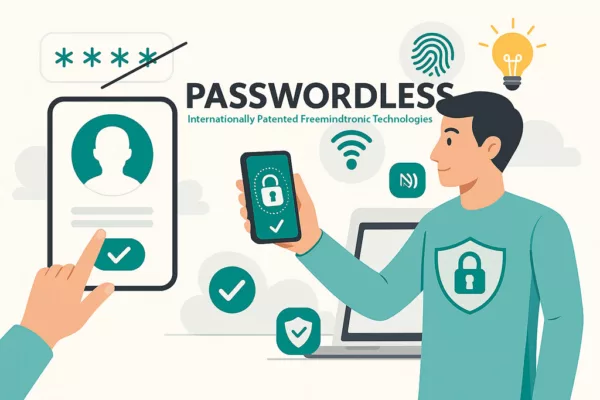
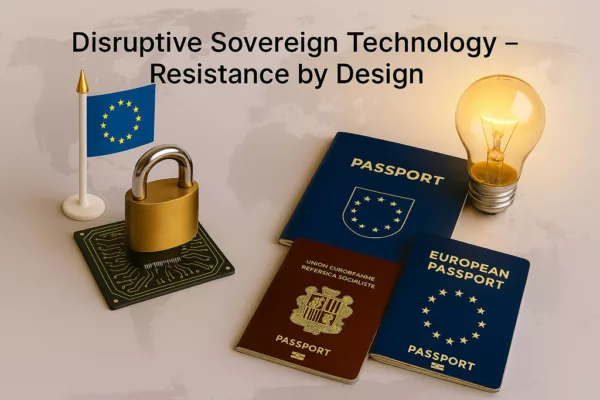


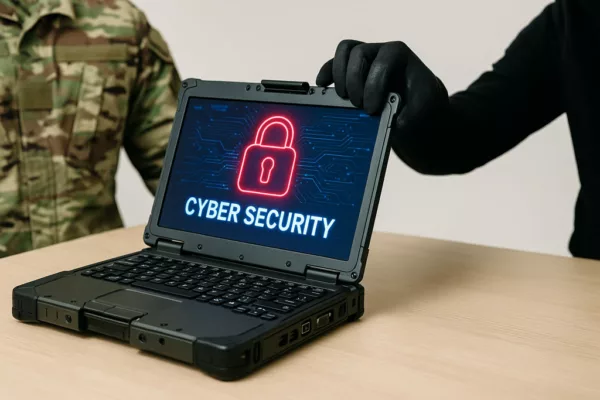

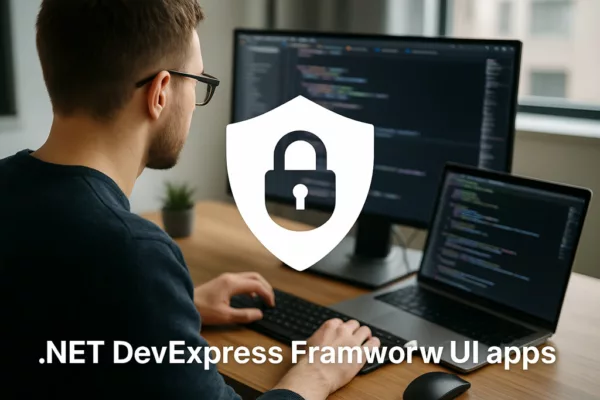
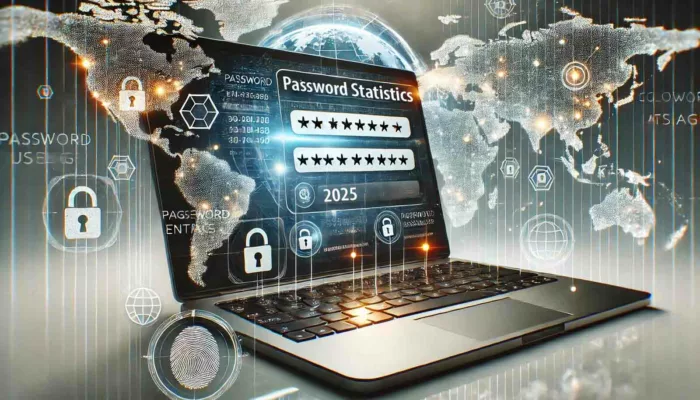




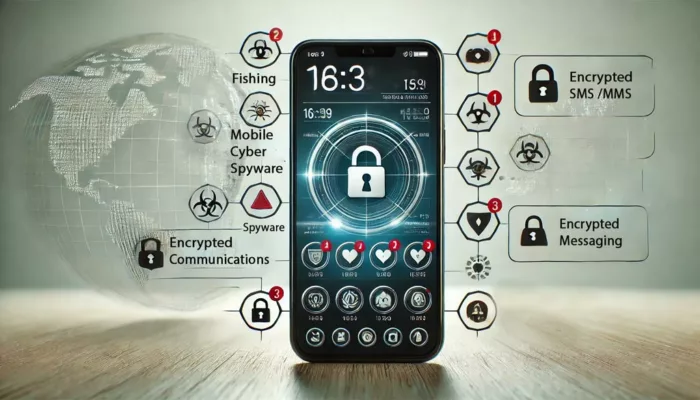







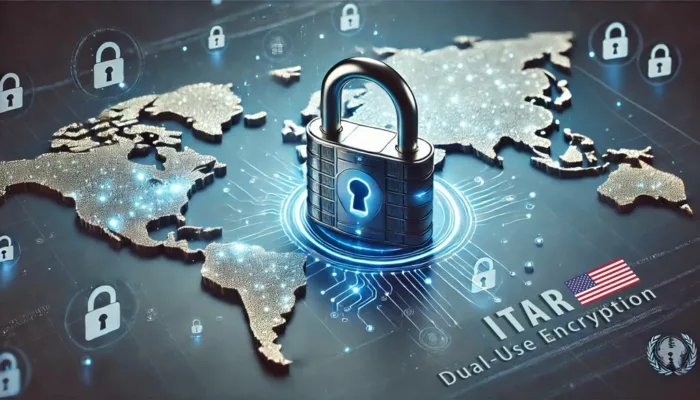
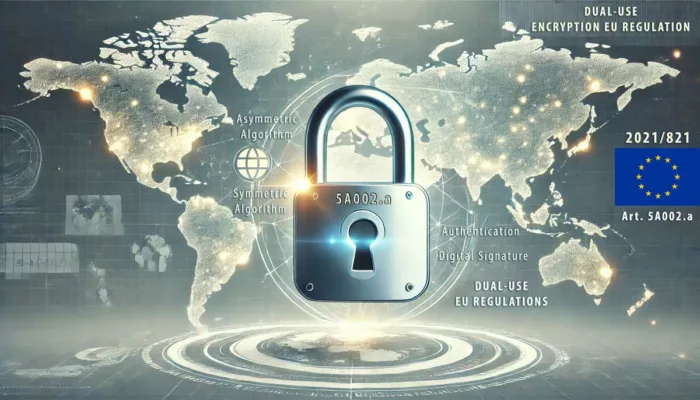


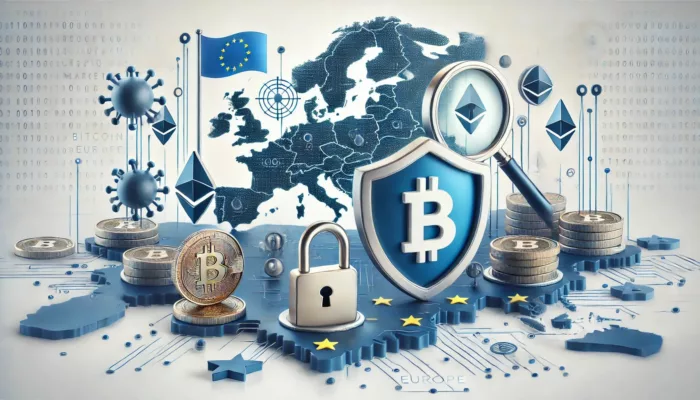





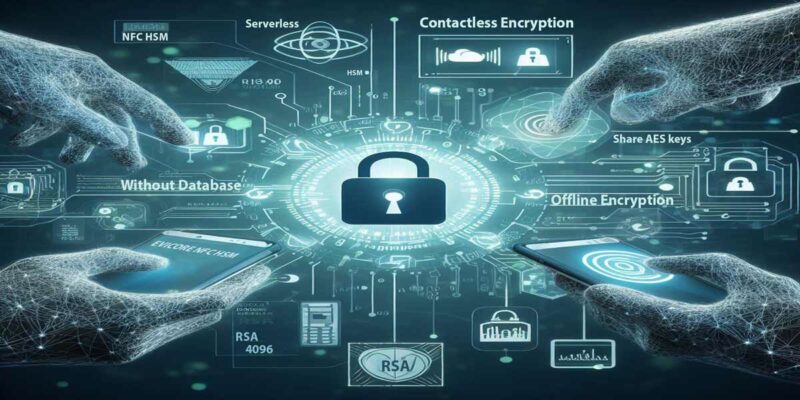






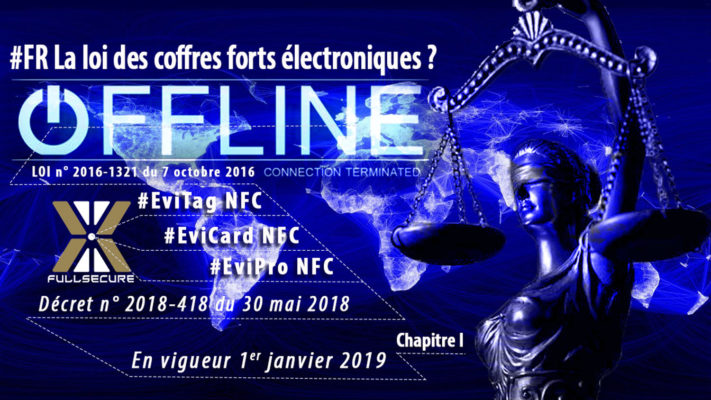



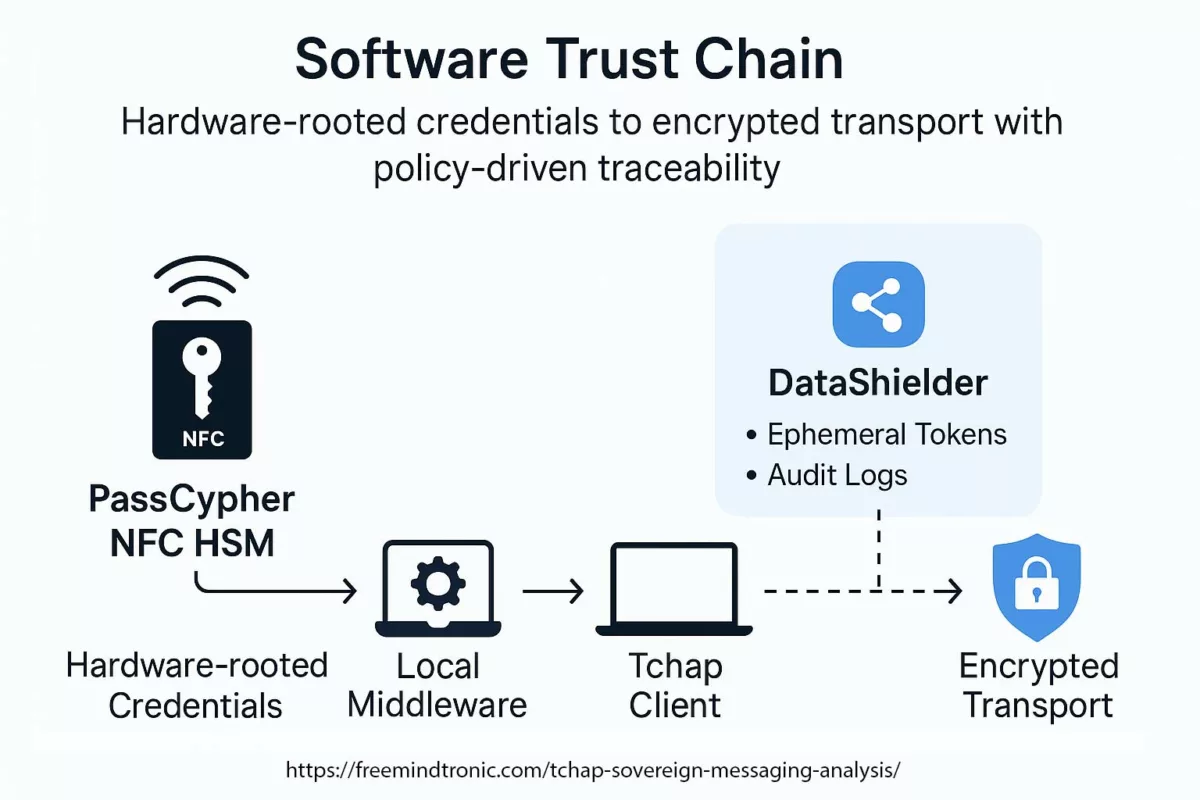
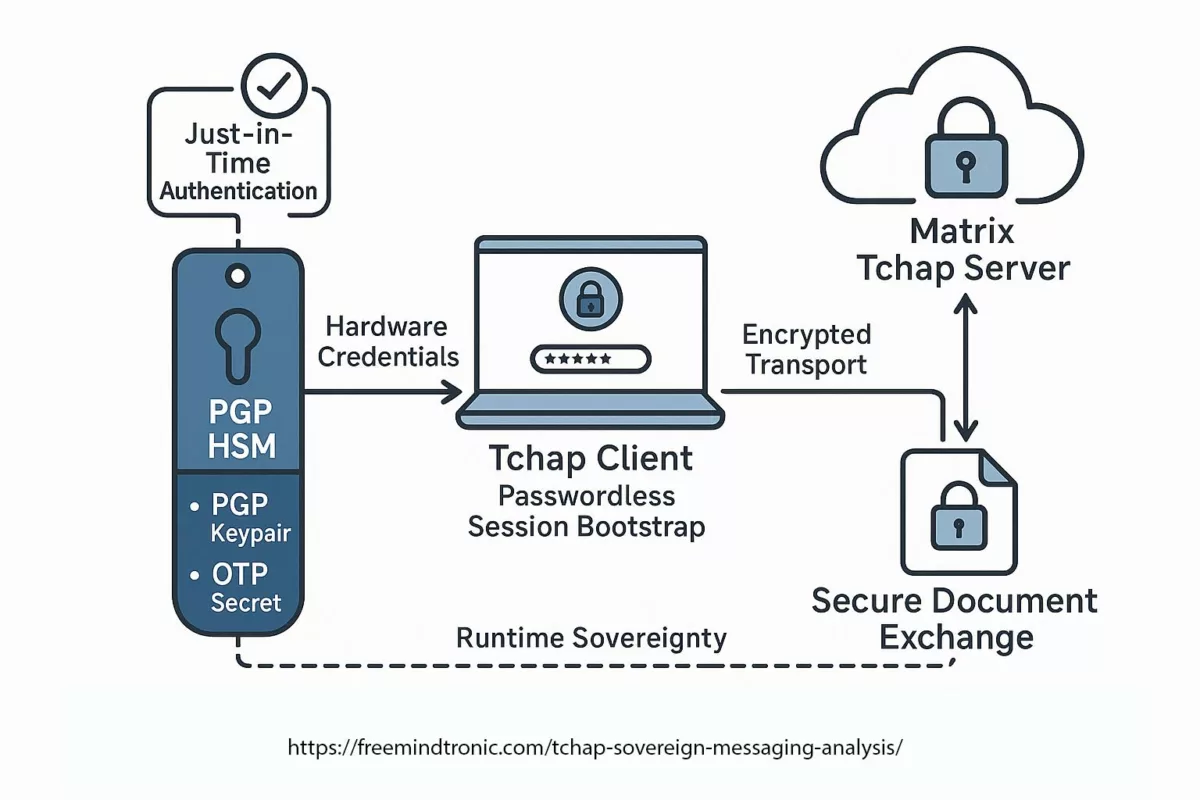
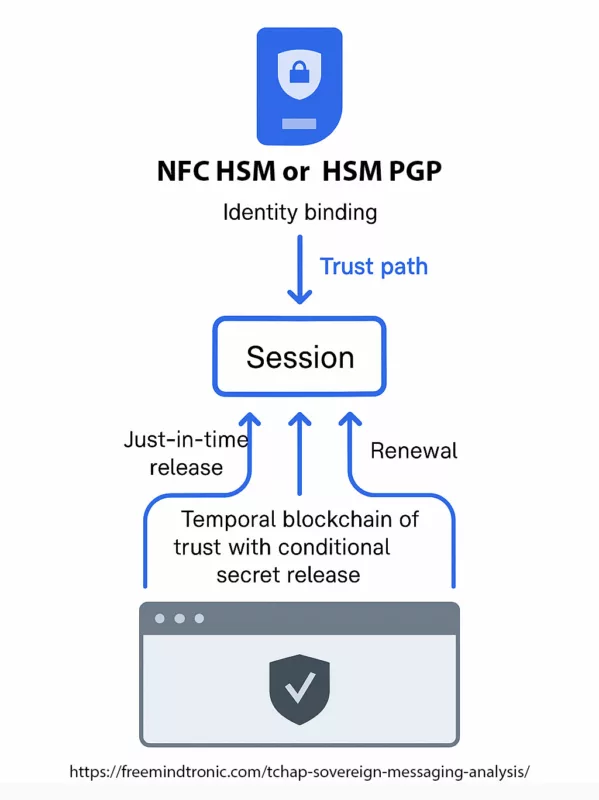
 ✪ Software Trust Chain — Mapping the flow of sovereign trust from hardware-generated credentials in PassCypher HSM, through local middleware, Tchap client validation, TLS 1.3 mutual authentication, and E2EE server layers.</caption]
✪ Software Trust Chain — Mapping the flow of sovereign trust from hardware-generated credentials in PassCypher HSM, through local middleware, Tchap client validation, TLS 1.3 mutual authentication, and E2EE server layers.</caption]

